1lumen selects and reviews products personally. We may earn affiliate commissions through our links, which help support our testing.
Imalent RS50 Review
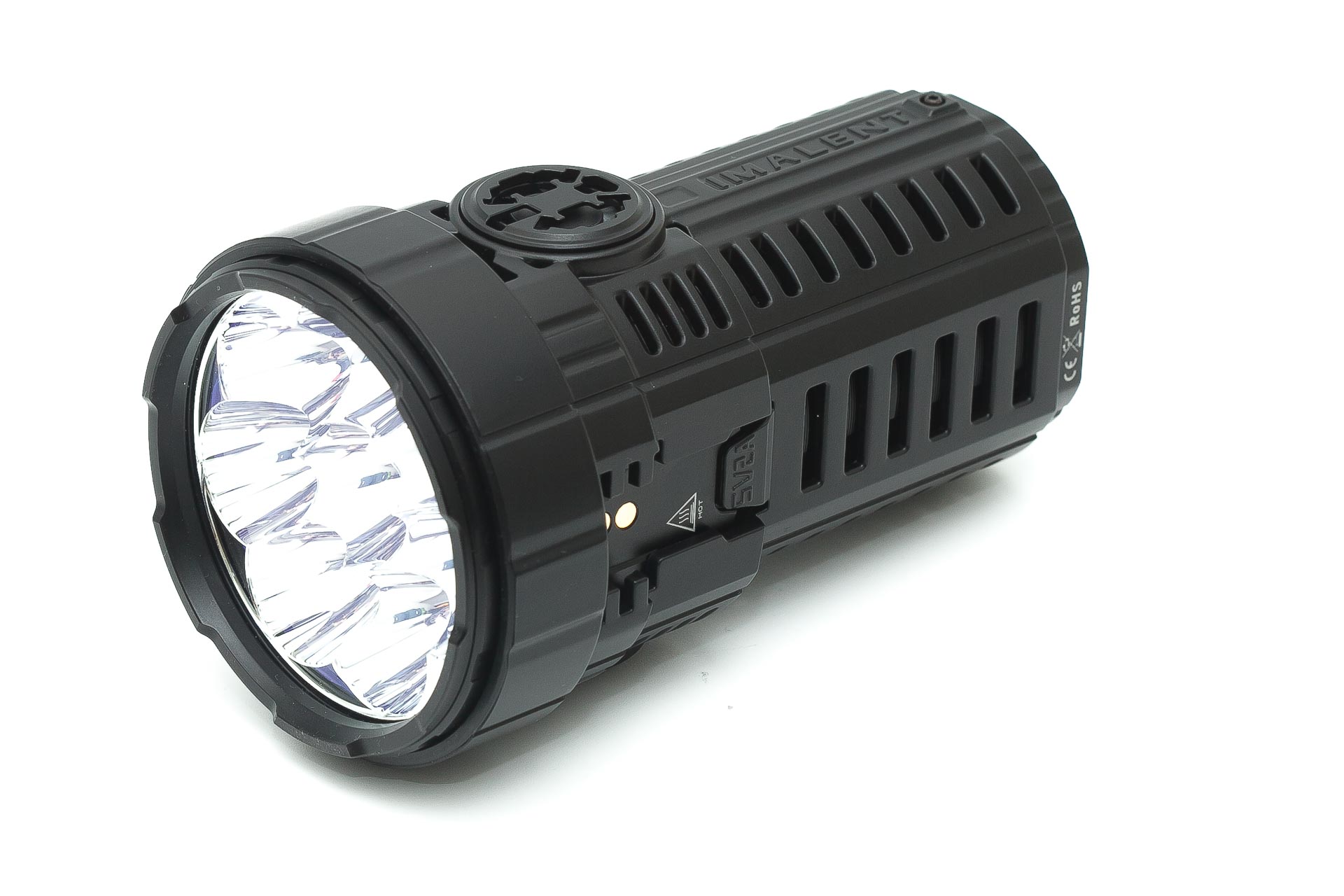
Imalent RS50 specifications
| Brand/model | Imalent RS50 |
|---|---|
| LED | 8*CREE XHP50.3 |
| Max. Lumens | 20,000 lm |
| Max. Beam intensity | 336,800 cd |
| Battery config. | 3*21700 |
| Onboard charging | Proprietary USB |
| Modes | 6 |
| Blinkies | N/A |
| Reflector | Smooth |
| Waterproof | IP65 |
| Review date | February 2022 |
Introduction:
If there is just 1 brand that produces high output flashlights, it’s definitely Imalent. They still hold the title of brightest flashlight in the world at the time of writing this review. It’s the Imalent MS18 with 100,000 lumens.
The RS50 doesn’t produce that many lumens, but 20,000 isn’t dim in my opinion. We’re looking at yet another high-power flashlight made by Imalent.
Unfortunately, it took 2 months for it to arrive, so this review is a little later than expected.
Package quality.
Imalent used a nice dedicated carton box. The outer part is just a shell and needs to be removed by sliding the inner box outward. Inside the box you can find the following:
- The flashlight: Imalent RS50
- Holster
- 2 O-rings
- 2 USB charging cables
- Extra screw for the plastic body
- 3 high end Imalent 21700 batteries (40T)
- Manual
It looks a lot like the Imalent MS08 we reviewed earlier.
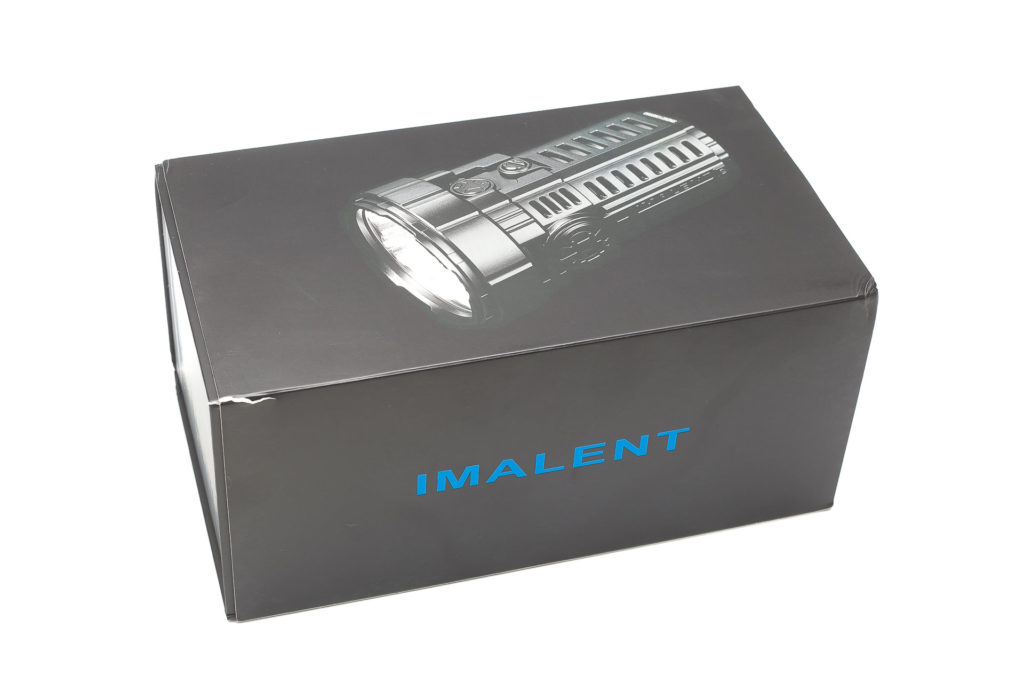
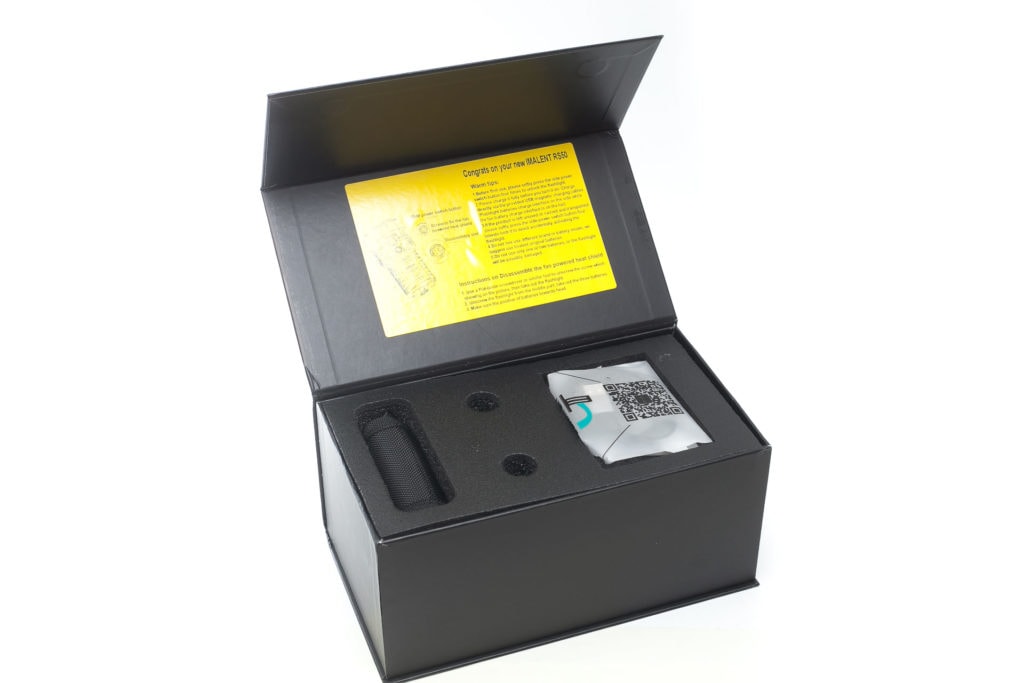
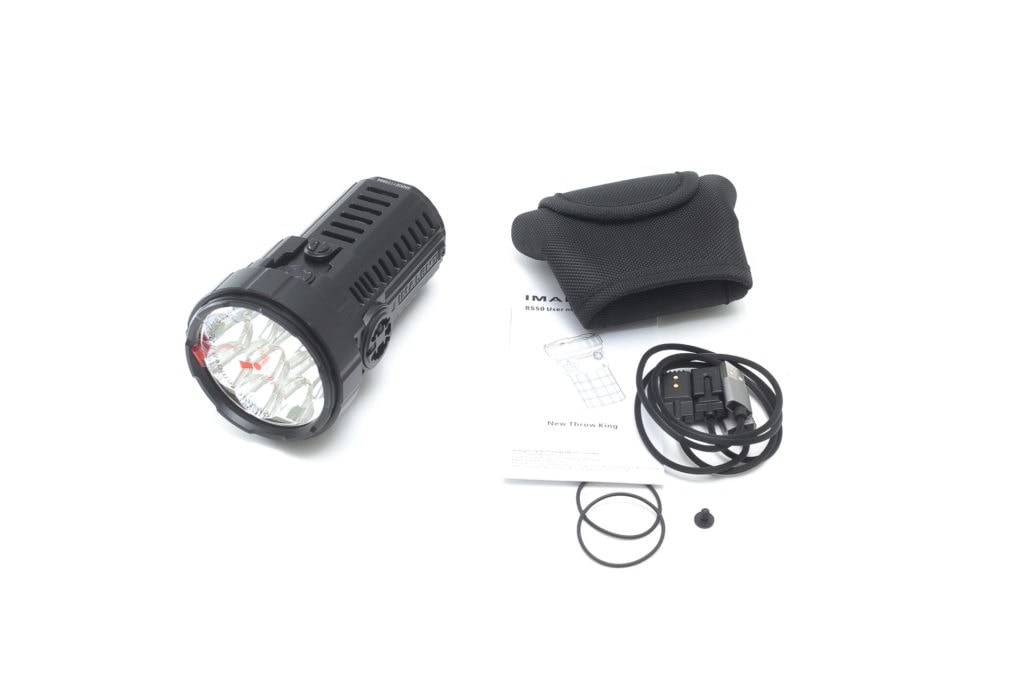
Flashlight in use
One of the first things you’ll notice upon opening is the futuristic-looking RS50. But what you’re actually looking at is a plastic housing that is supposed to keep the flashlight cool with 2 built-in fans.
The fans blow wind onto the flashlight (not away from it) and the (hot) air leaves through the holes in the plastic housing. The housing itself has a tiny battery built-in and lasts for a little short of 2 hours. The fans are activated manually and aren’t electronically connected to the flashlight. There is no thermal management that control the fans.
You activate the fans with the switch at the back. The fans only have a single speed.
The side switch on the RS50 is used for power and mode switching. So keep that in mind that you need to keep a charge in the battery for the fans to work. Otherwise, your light can probably not spread the heat, and likely overheat. The main benefit of using this plastic shell is to protect your fingers from burning, lol.
There are 2 indicator LEDs on each side of the body that can be activated and deactivated. When turned on, you should be able to locate the flashlight better in the dark. But it also helps to tell you where NOT to push, because the switch is very hard to find in the dark. It’s actually impossible without having some guidance.
In terms of size, it’s definitely a soup can-sized flashlight, even with the plastic housing.
There’s no lanyard attachment toward the rear, so you kind of have to use the holster. But if you have large pockets in your coat, this might even fit. There is also no tripod attachment point, so that could be a con!
The rear end is flat, so you can make it tailstand without an issue.
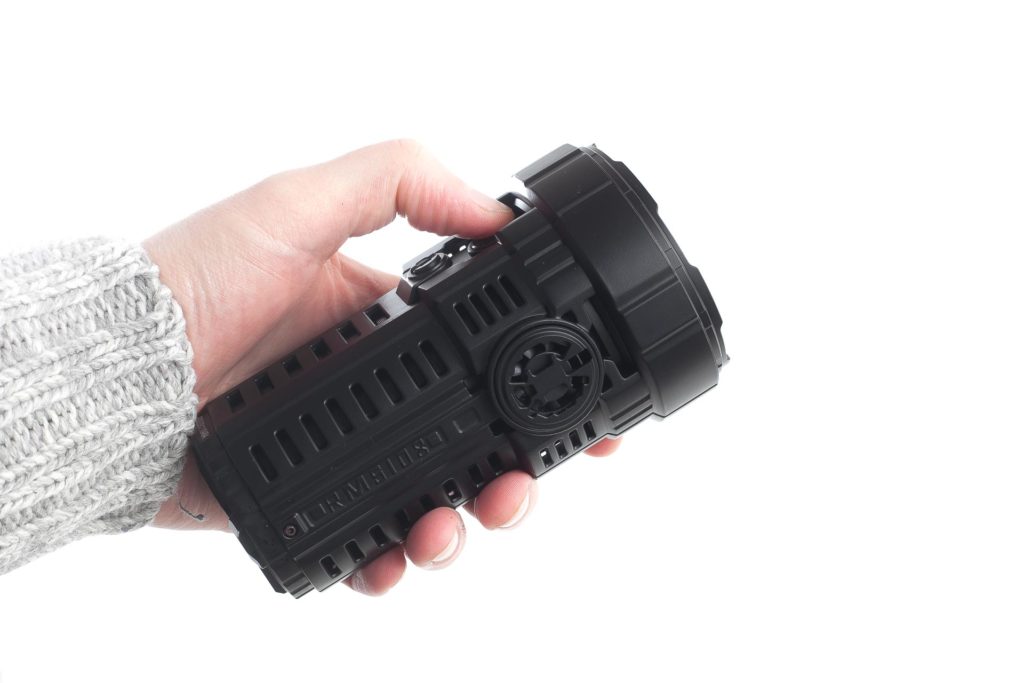
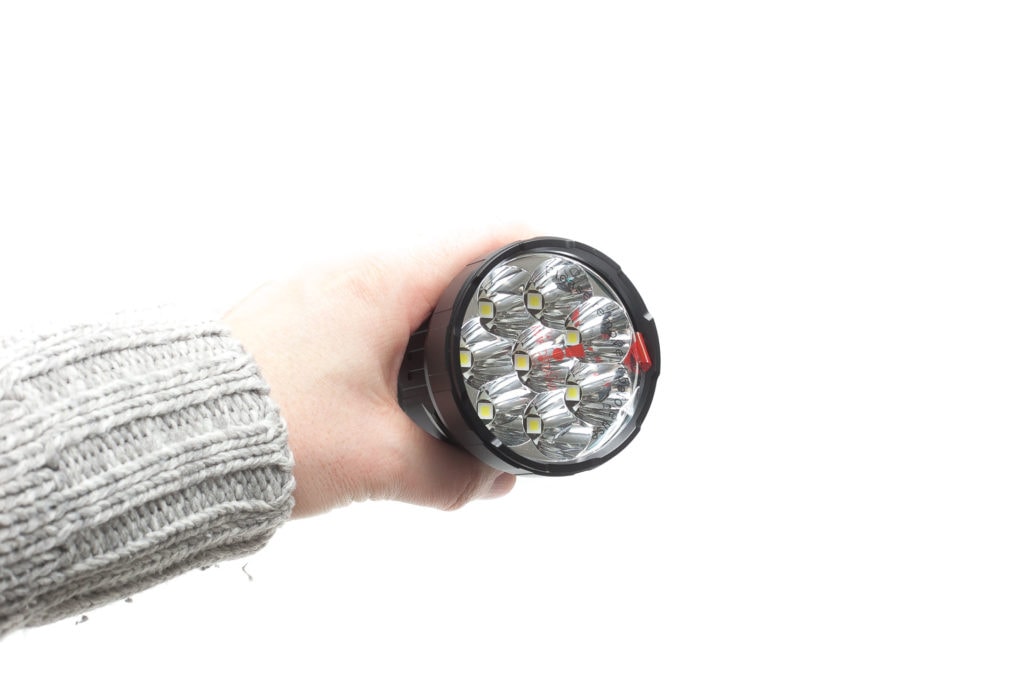
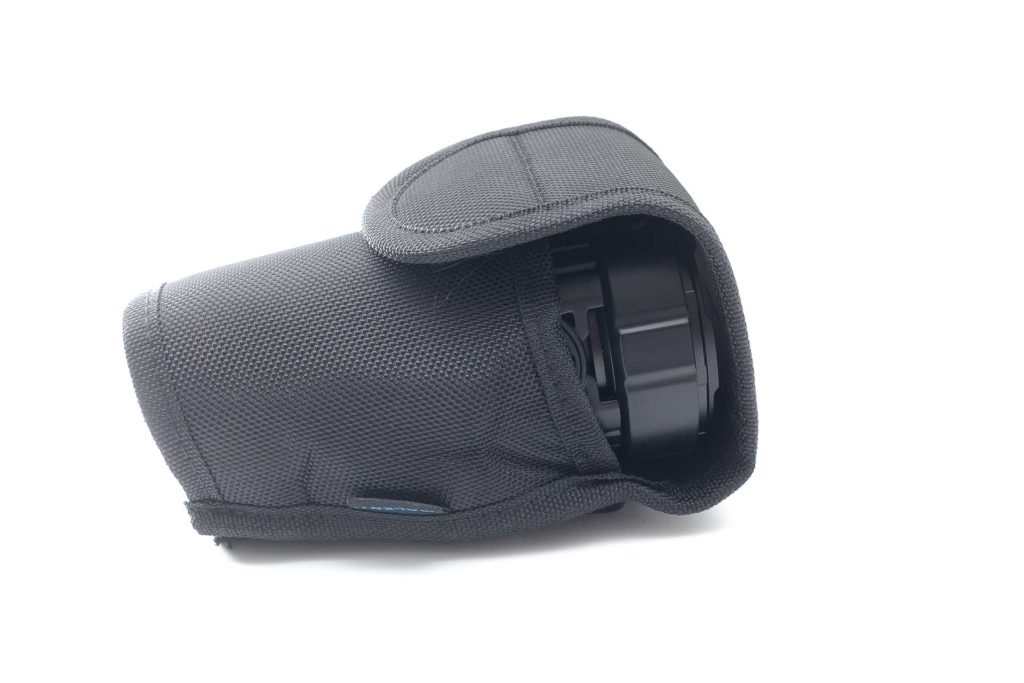
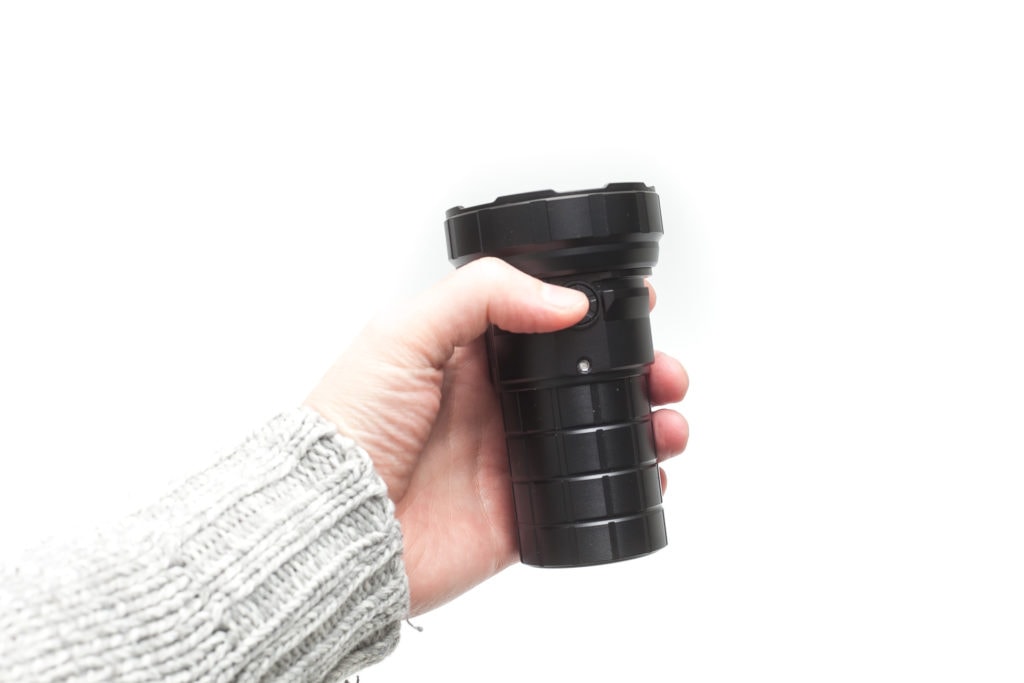
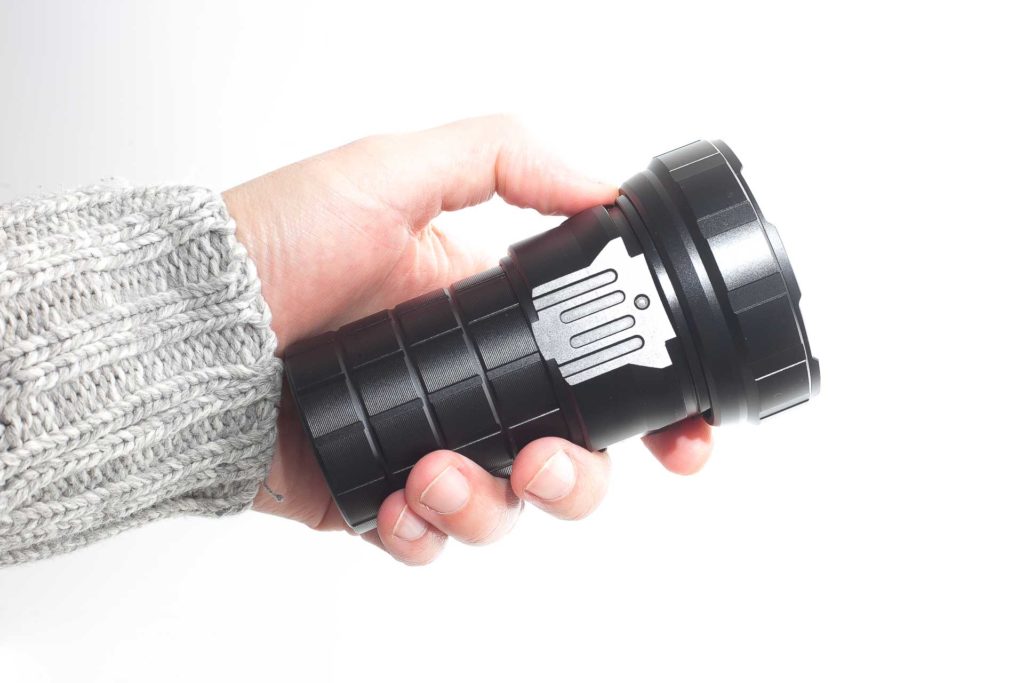
Build Quality, and Warranty
You can easily see the similarities between this RS50 and all the Imalent MS flashlights. The coating looks the same, the knurling/machining and threads all look the same.
I’d love to see a little more smooth finish when it comes to anodization. I also prefer smoother edges to make it look a little higher-end. And I wouldn’t complain if it had a stainless steel bezel…
The threads were lubed, and are square cut. And there’s a single o-ring to keep water out.
Imalent also included a holster with a velcro strap at the back, a sown loop, and a plastic ring to attach it to a belt.
Imalent’s warranty
- Free Repair/Replacement within 15 Days after Receipt
Within 15 days after receipt and under normal use, any quality problem with your IMALENT flashlight, you can either send the light to repair or a new one of the same type with same specifications will be replaced; if the same model has been discontinued or not able to be replaced timely due to other reasons, another model with same or better performance will replaced instead;
2. 60 Months’Free Repair
Within 60 months after receipt and under normal use, any quality problem with your IMALENT flashlight, you can send it to repair for free;
Lifetime Limited Maintenance
IMALENT provides you with lifetime limited maintenance for your flashlight, after the 60 months free repair period , any problems with your flashlight, IMALENT can repair and maintain it, repairing fee will be charged on an actual cost basis, no labor cost charged;
The warranty is nullified in all of the following situations:
- The product(s)is/are broken down, reconstructed and/or modified by unauthorized parties.
- The product(s) is/are damaged through improper use.
- The product(s) is/are damaged by leakage of batteries.
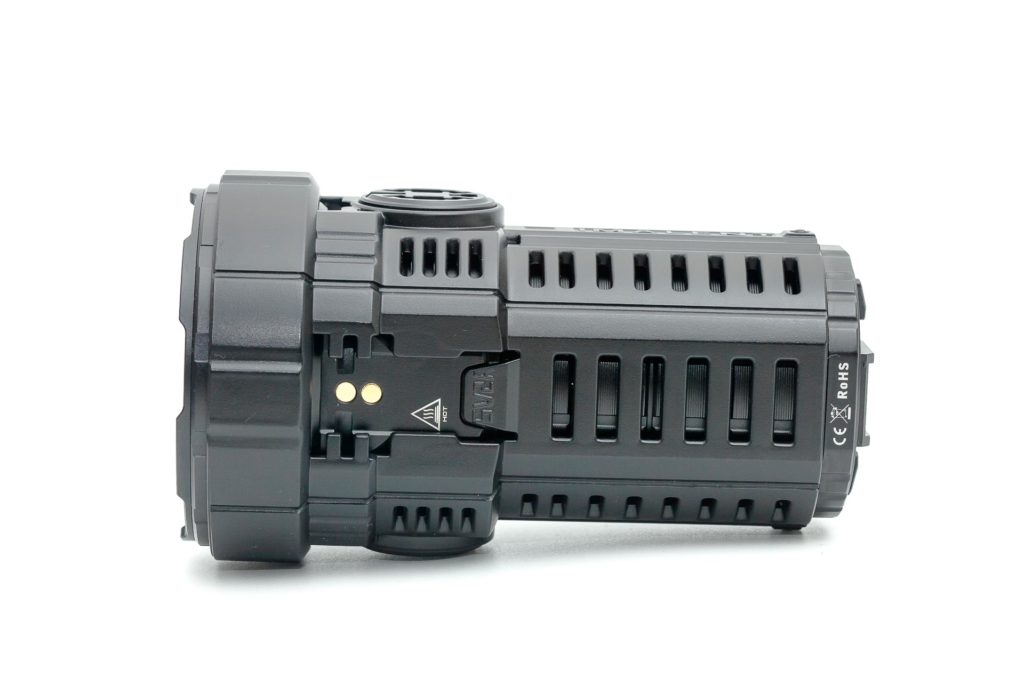
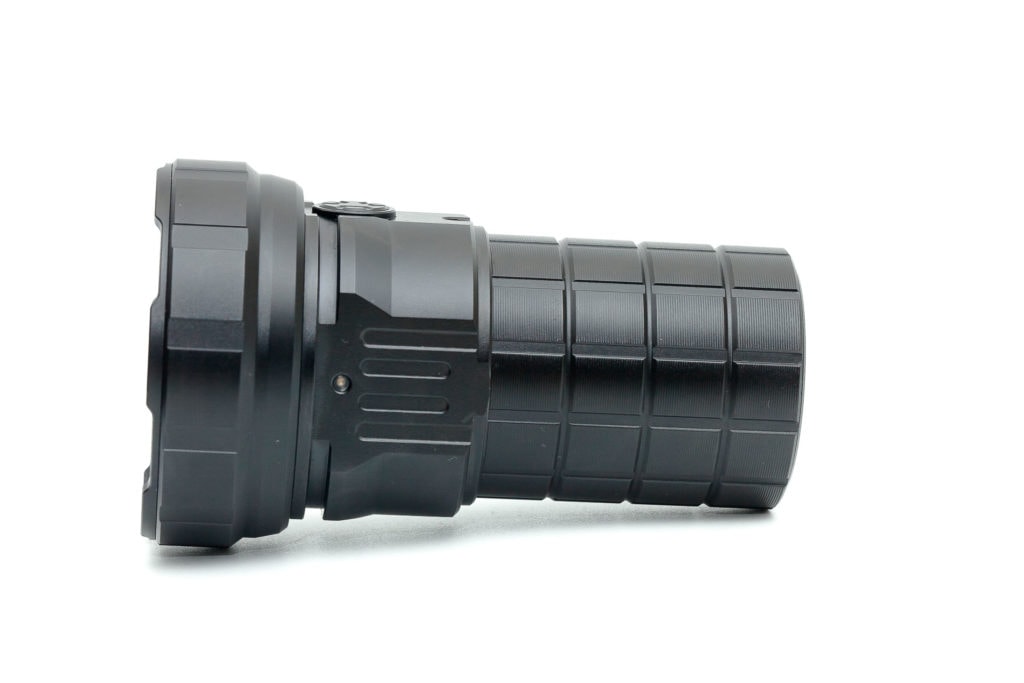
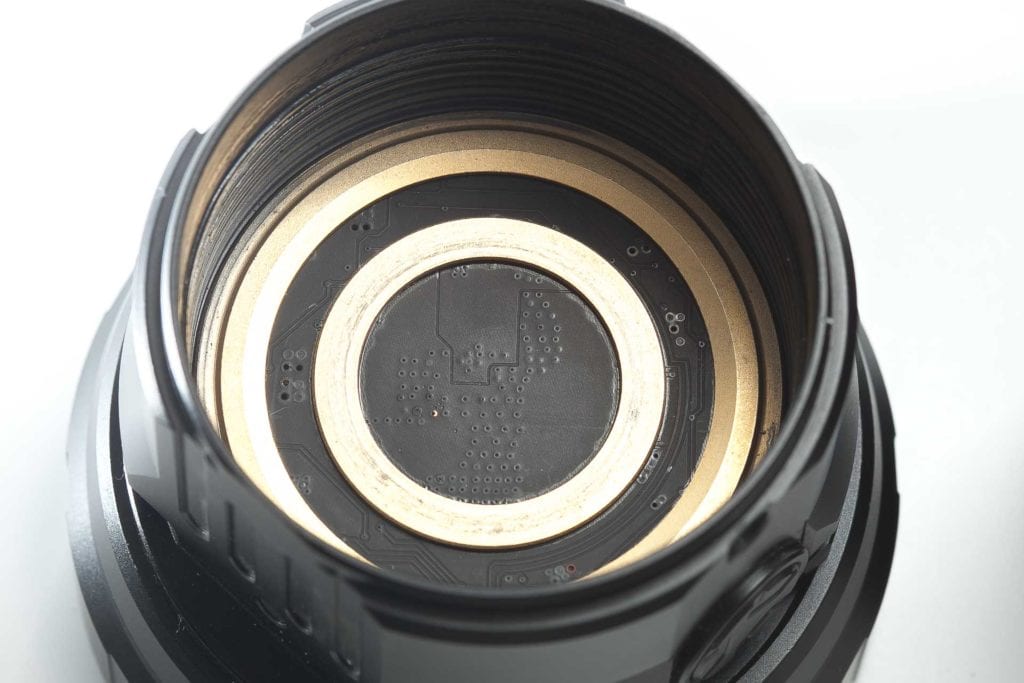
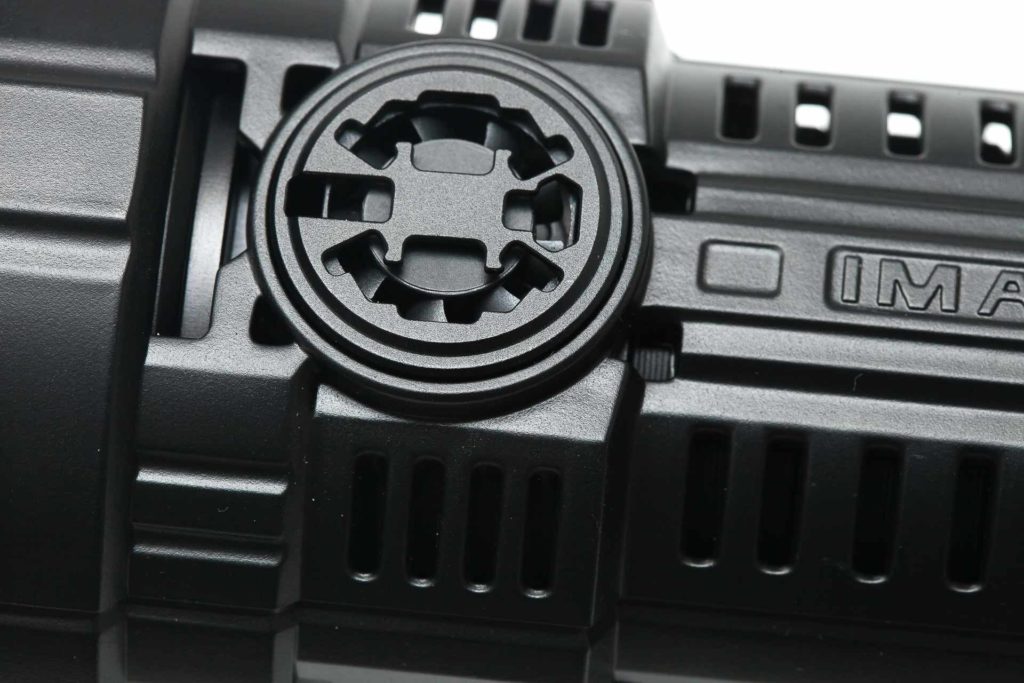
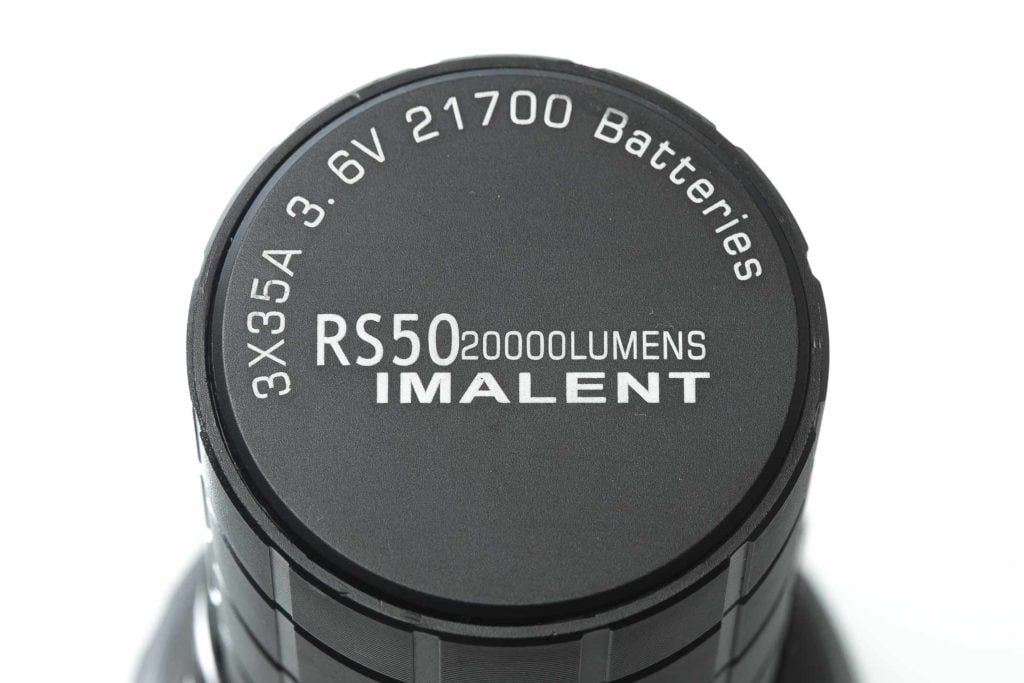
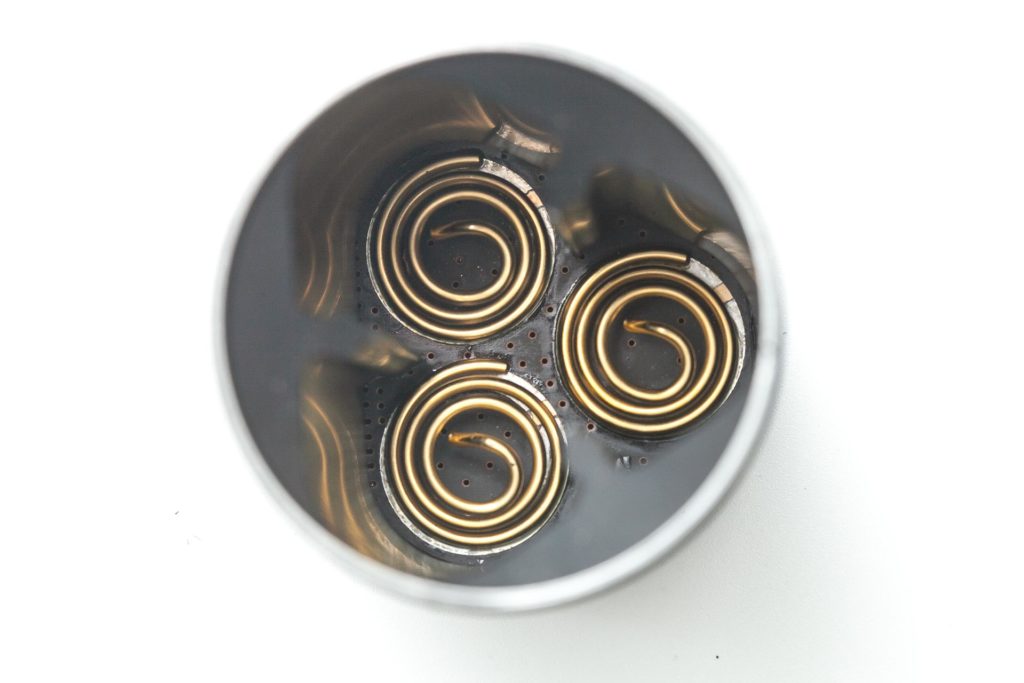
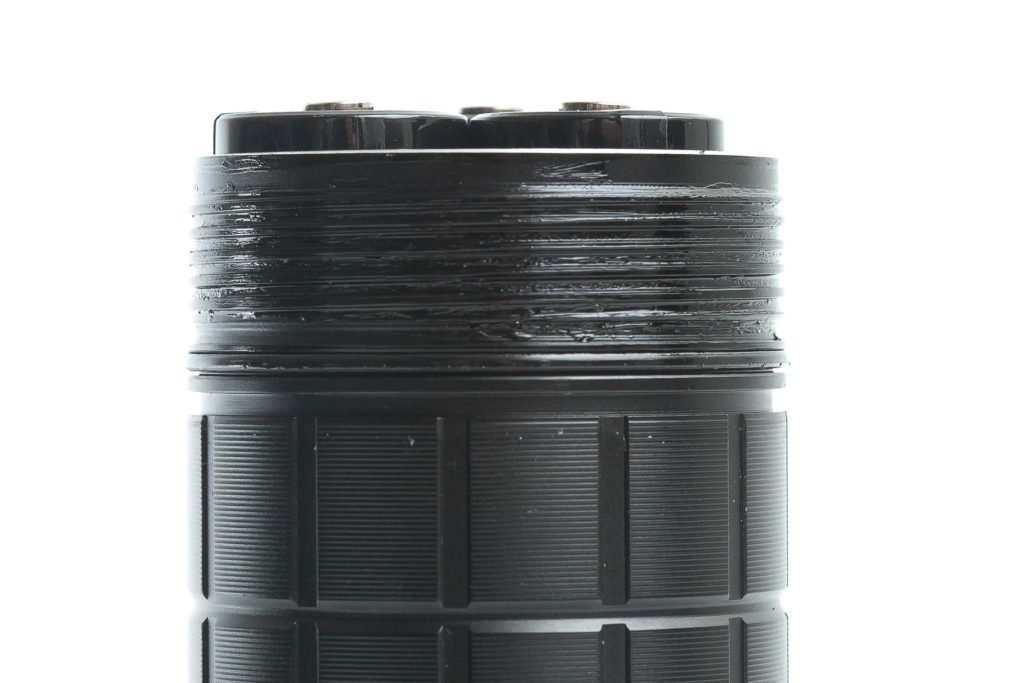
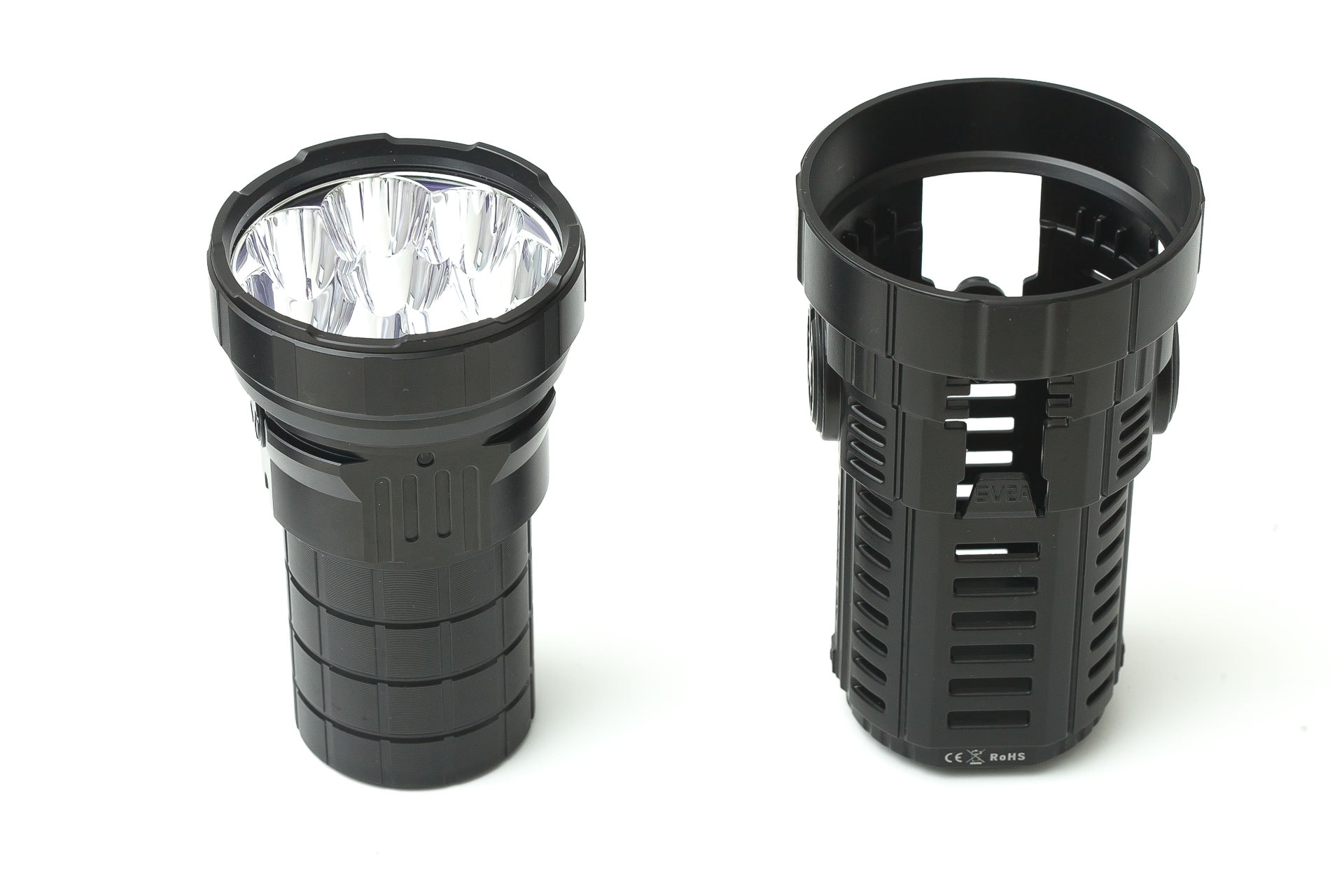
LED, Lens, Bezel, Beam, and Reflector
The Imalent RS50 uses 8*CREE XHP50.3 LEDs to reach the claimed 20,000 lumens. And these LEDs produce a lot of heat, so you definitely need to use those fans when powered in 1 of the highest modes.
They all sit in 8 shallow reflectors and are centered pretty well. I don’t know how they do that, but that’s definitely a pro.
We’ll have to see if it can reach 20,000 lumens, let alone, maintain it for more than 10 seconds, and I’m afraid it can’t. Don’t trust me on my word, because we’ll test that.
In recent weeks I have been diving a little deeper into measuring CRI, and I used to measure the beam in my homemade integrating sphere. Doing it that way, the measurements are very stable, but are a mix of measurements. CRI and DUV depend on the position of the beam. Center and spill have different measurements, and measuring in an integrating sphere will combine hotspot, spill, and everything into 1 measurement. That’s not the best way to measure.
This time, I just point the light directly at the Opple Light Master Pro, and focus the center of the beam onto the sensor.
- CCT 7230
- Ra 72.3
After a certain output, you can’t really make up colors much anyway, so I don’t add the DUV
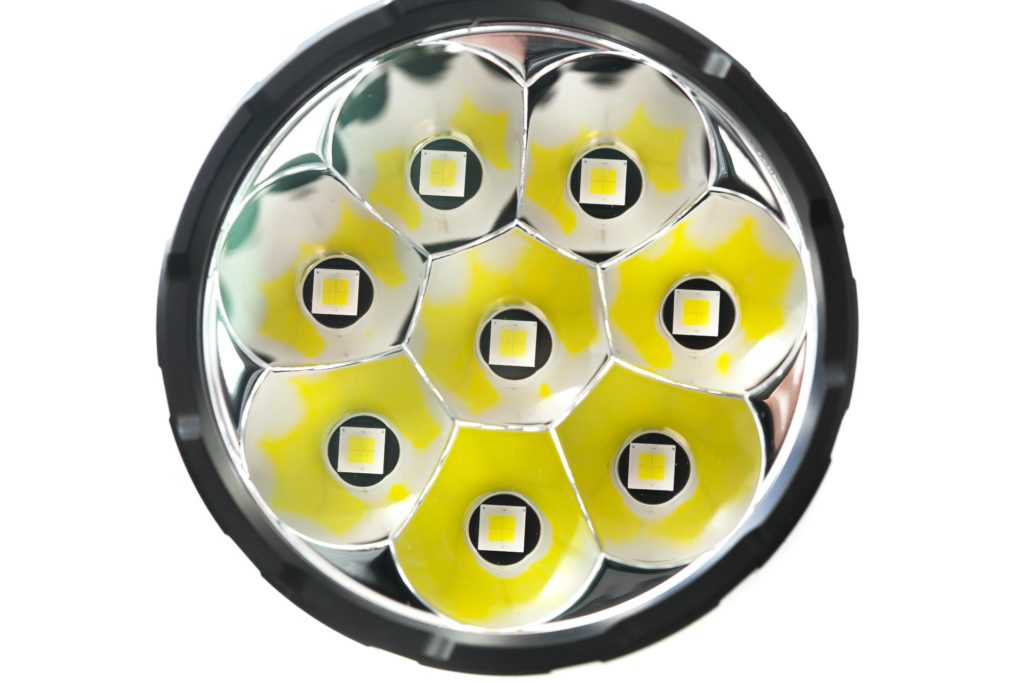
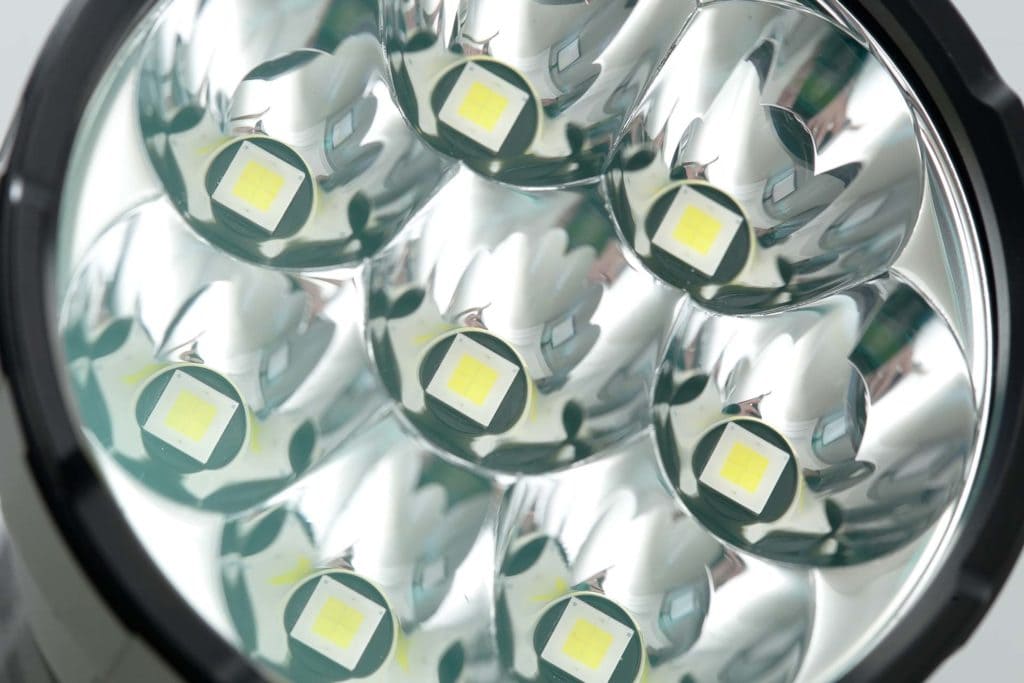
Dimensions and size comparison
With the plastic housing:
- Length: 137.7 mm / 5.42 ”
- Head diameter: 79.3 mm / 3.12 ”
- Body diameter: 60.2 mm / 2.37 ”
Weight:
- With shell: 776.7 g / 27.4oz
- Without shell: 653.6 g / 23.06 oz
- Without shell, without batteries: 436.2 grams / 15.39 oz.
Powerful Flashlights comparison
Size compared to some of the most powerful flashlights.
Image 1, from left to right: Manker MK38, Olight Marauder 2, Acebeam X50, Imalent MS08, Imalent RS50, Acebeam X80-GT, Acebeam X80-GT2, Lumintop GT3.
And compared to the Imalent MS08
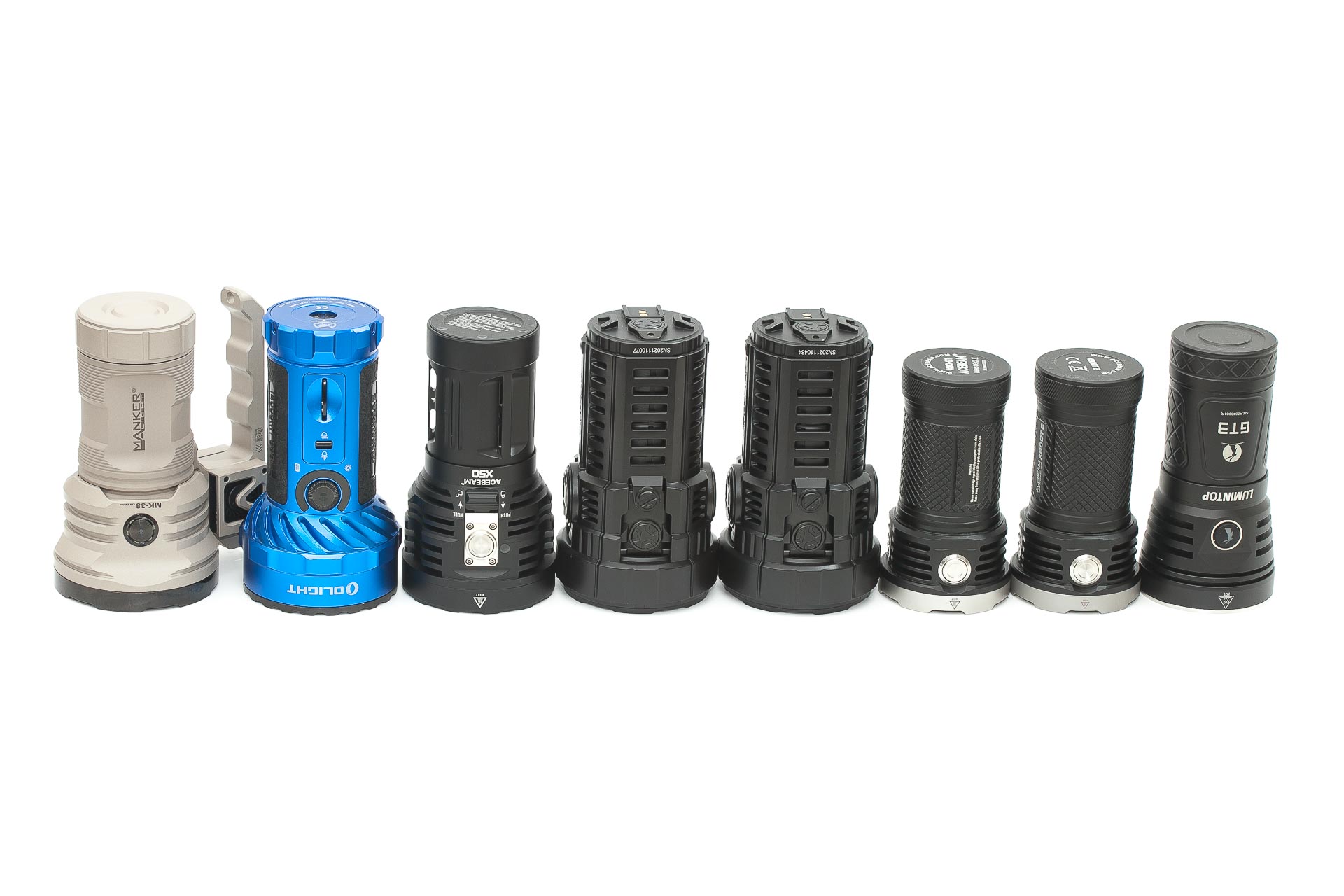
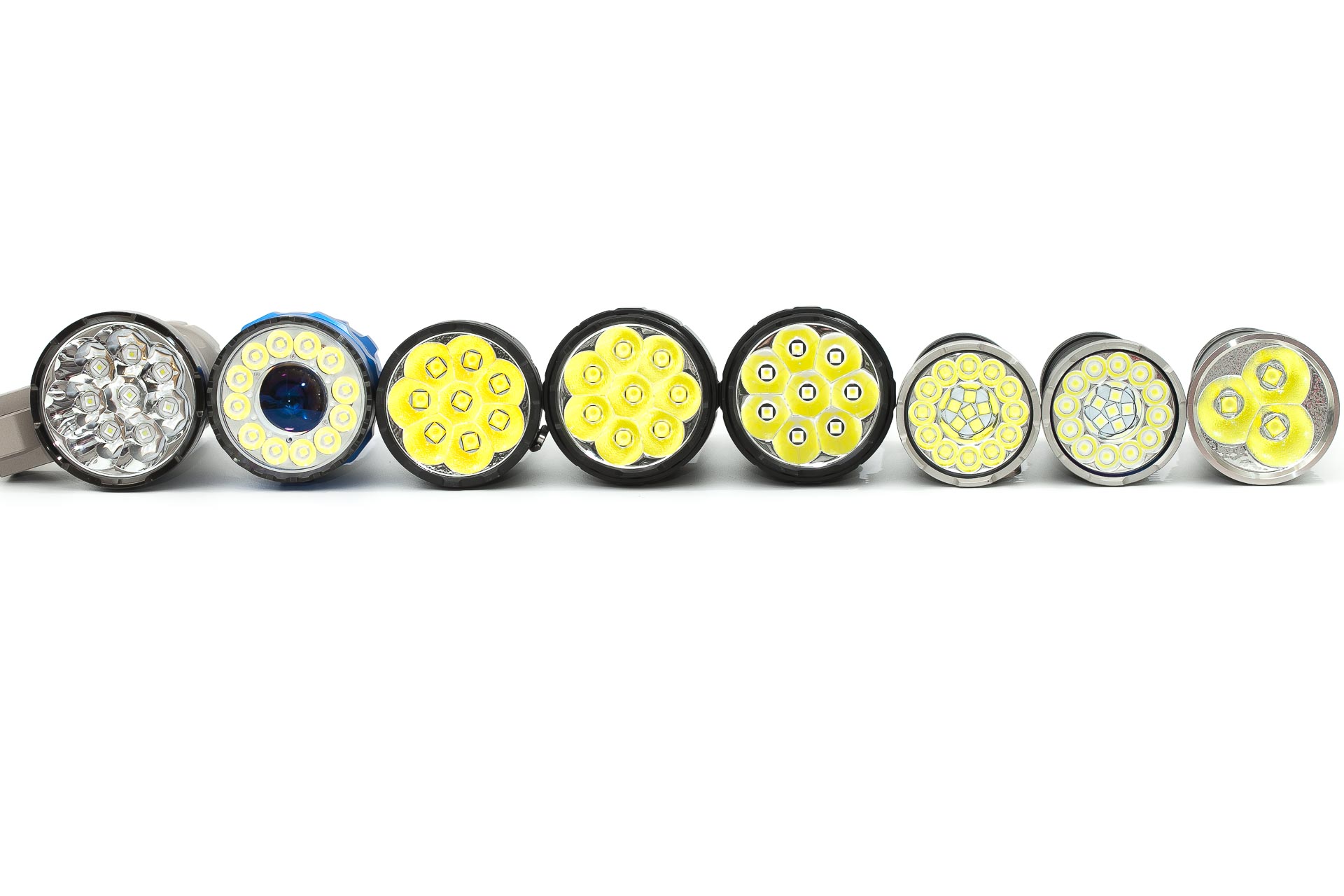
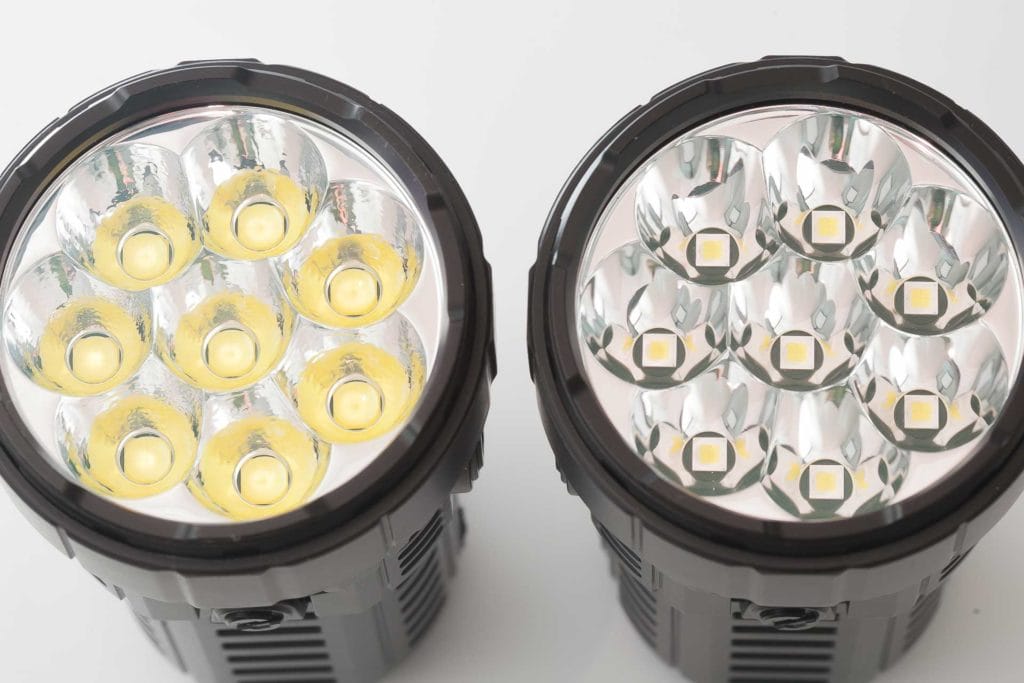
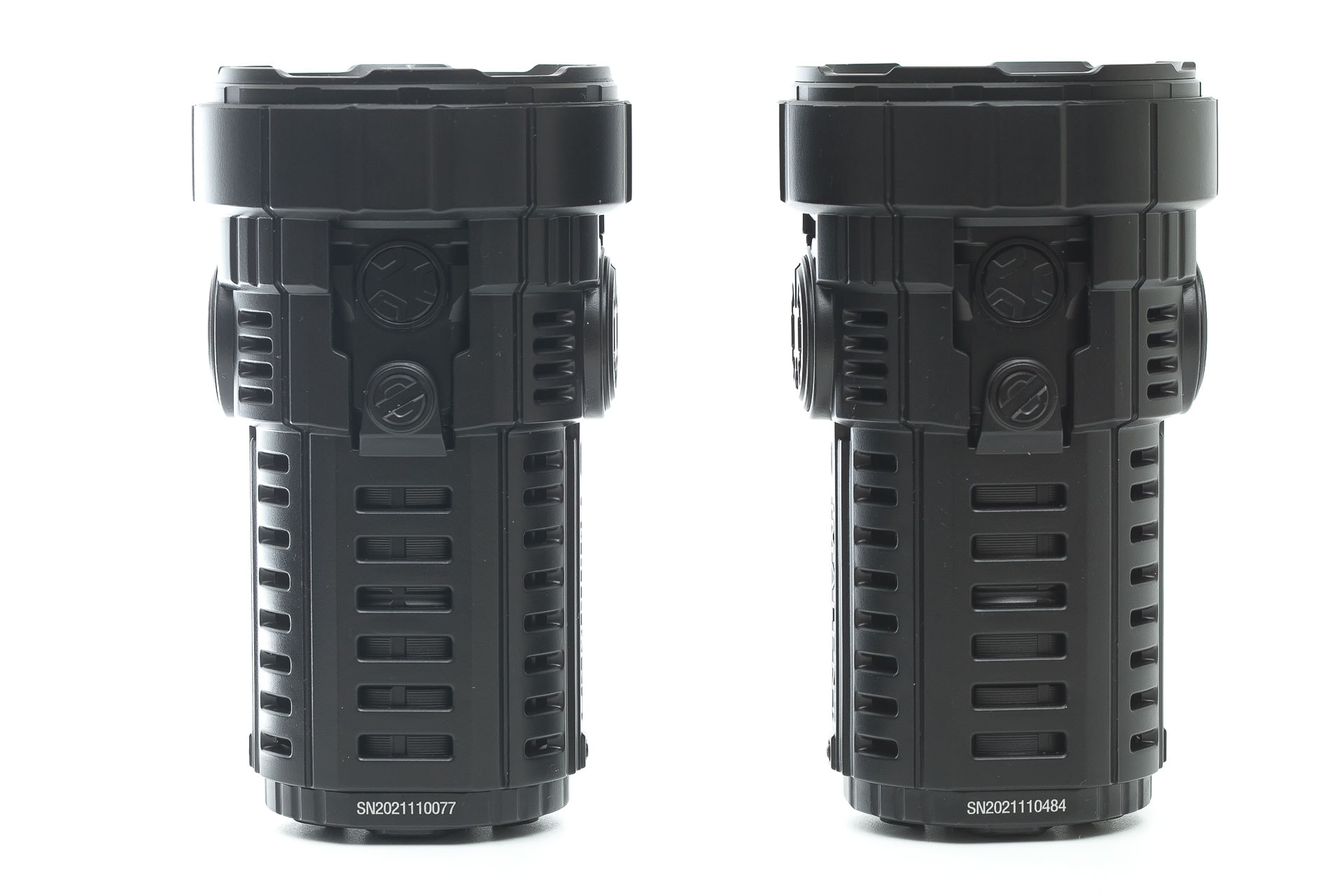
Driver & User Interface:
Available modes:
- Low, Middle Low, Middle 1, Middle 2, High, Turbo
From OFF:
- Single-click: to last used mode ( mode memory)
- Double click: Turbo
- Triple-click: Low mode
- 4+ clicks: Lockout
- Press and hold: turn on indicator LEDs on 2 sides of the head (repeat to turn them off again)
From ON:
- Single-click: off
- Double click: Turbo
- Triple-click: Low mode
- Press and hold: Cycle through the menu from Low to High
Shortcuts:
- To Turbo: double click from Off or On
- To Low: 3 clicks from Off or On
- To Strobe: there is no strobe
Mode memory:
- Yes (single click from off returns ot last used mode)
Blinky modes menu:
- None
Low battery warning:
- The red indicator lights on the side will flash, and the output will drop before it turns off.
Lock-out mode:
- 4+ clicks from off. The green indicator lights blink 3 times to indicate the lockout mode is activated. Repeat 4 clicks to deactivate again. You can also do 5 clicks or 10 clicks.. works the same.
PWM:
- Not visible
Batteries & Charging
After charging 4.16V measured with Fluke
Imalent provides 3 high discharge batteries that arrived at 3.15V each. These are button top cells and labeled: Imalent MRB-217P40S, and if you look at the following pictures, you can see some text behind the wrappers, indicating these to be Samsung INR21700 40T. These are good, high-quality cells. There is only 1 thing that I don’t like so much about the text on the wrapper, saying these have protection boards, but our fellow reviewer Owen took the wrapper off, and only found a spacer, without any electronics.
You could use your own button tops, but flat tops won’t work. Oh, and if you use protected cells, make sure they have their cut off voltage high enough!
Charge speed is about 2A… and takes between 6-6.5 hours to charge with the included charger. Batteries are charged to 4.16 V when measured with my Fluke after it is finished charging.
The 2 indicator LEDs on both sides of the flashlight are lit red during charging, and turn solid green when finished.
The plastic shell has a tiny battery built in, that is charged with the same kind of charging cable as the batteries inside the flashlight. The battery inside the plastic shell can run for almost 2 hours. Enough for Turbo mode and High mode, just not enough for Middle 1.
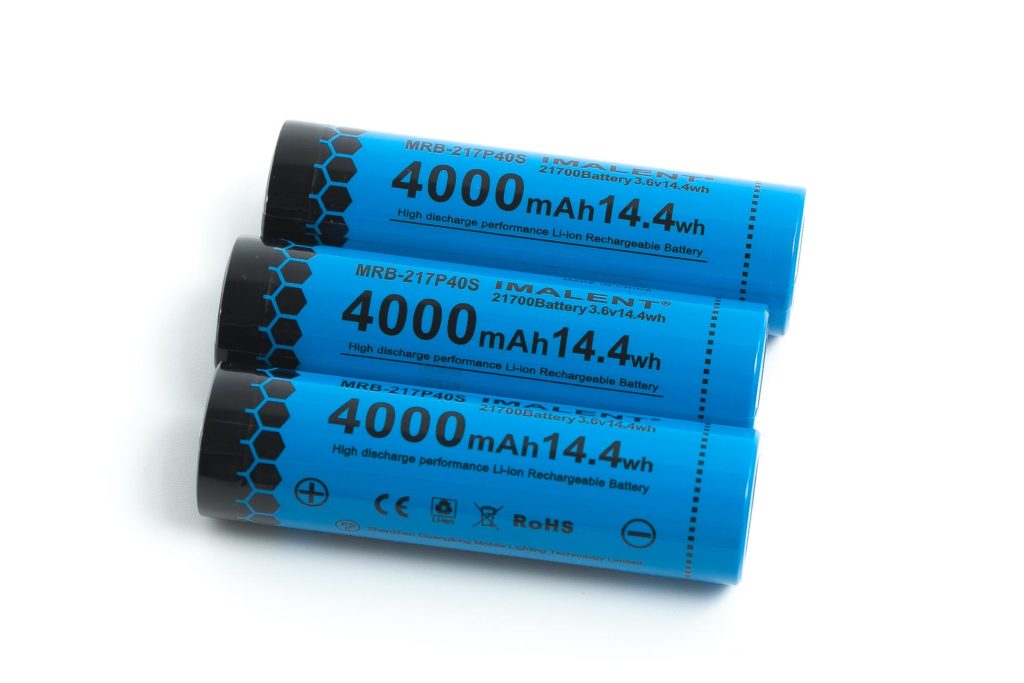
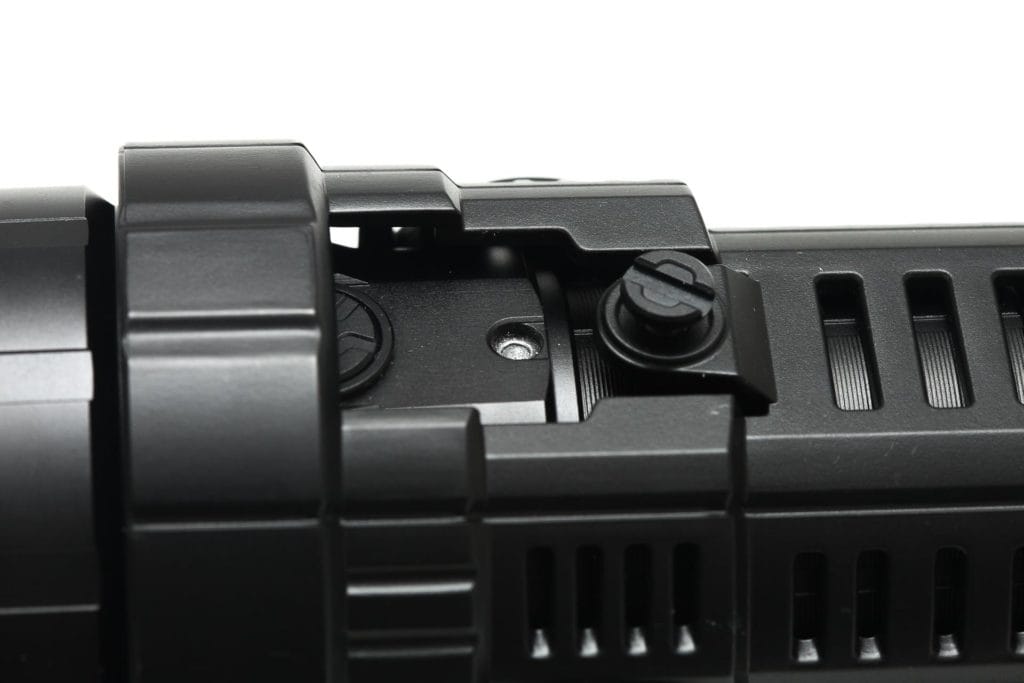
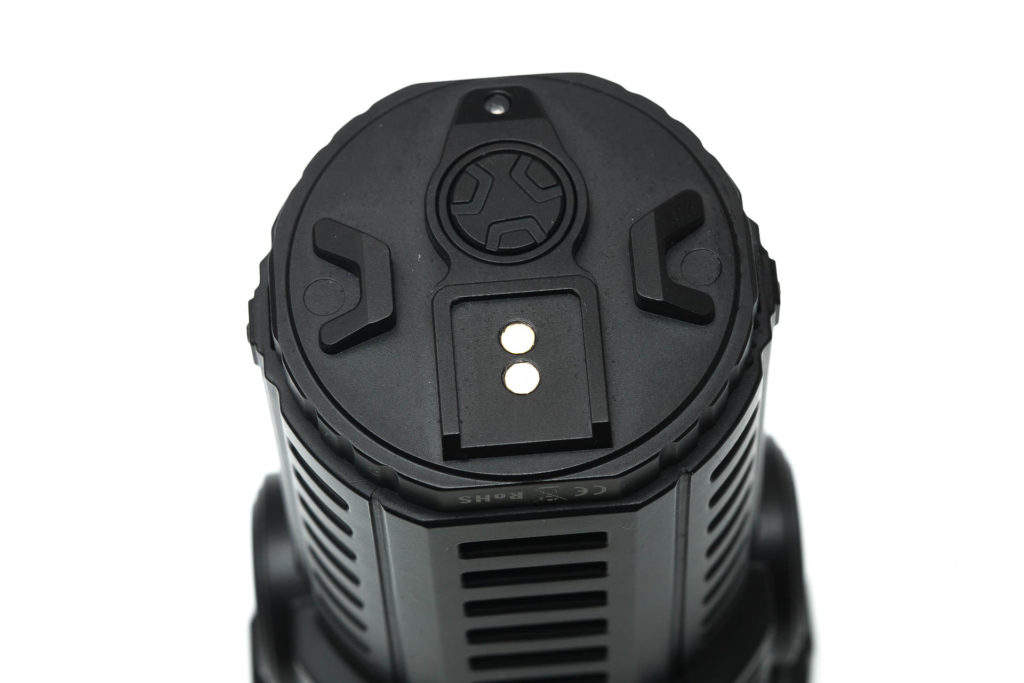
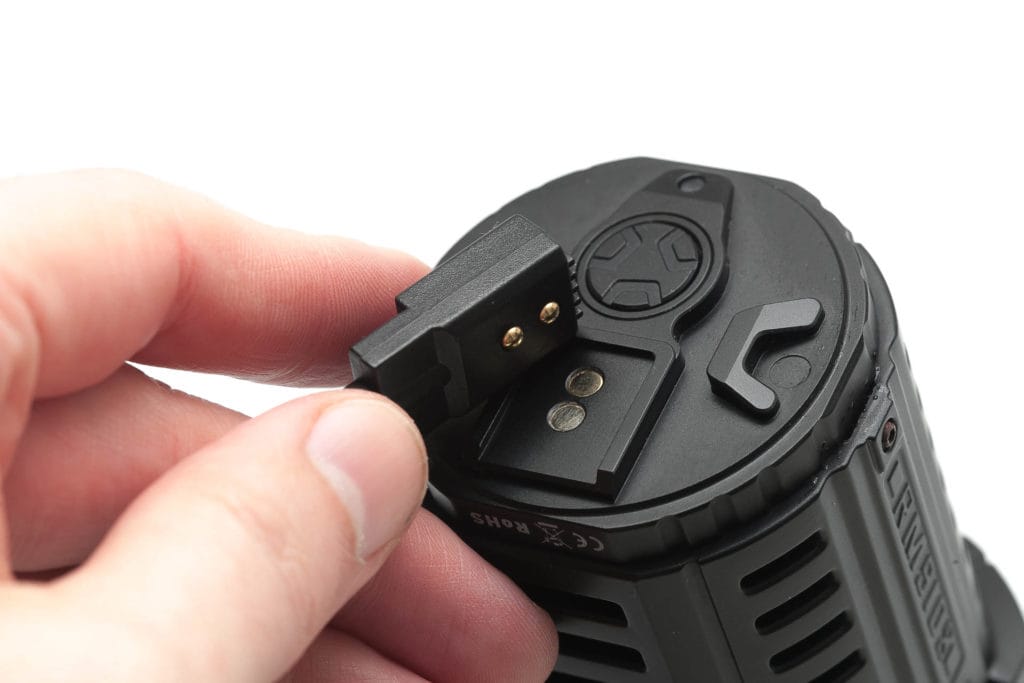
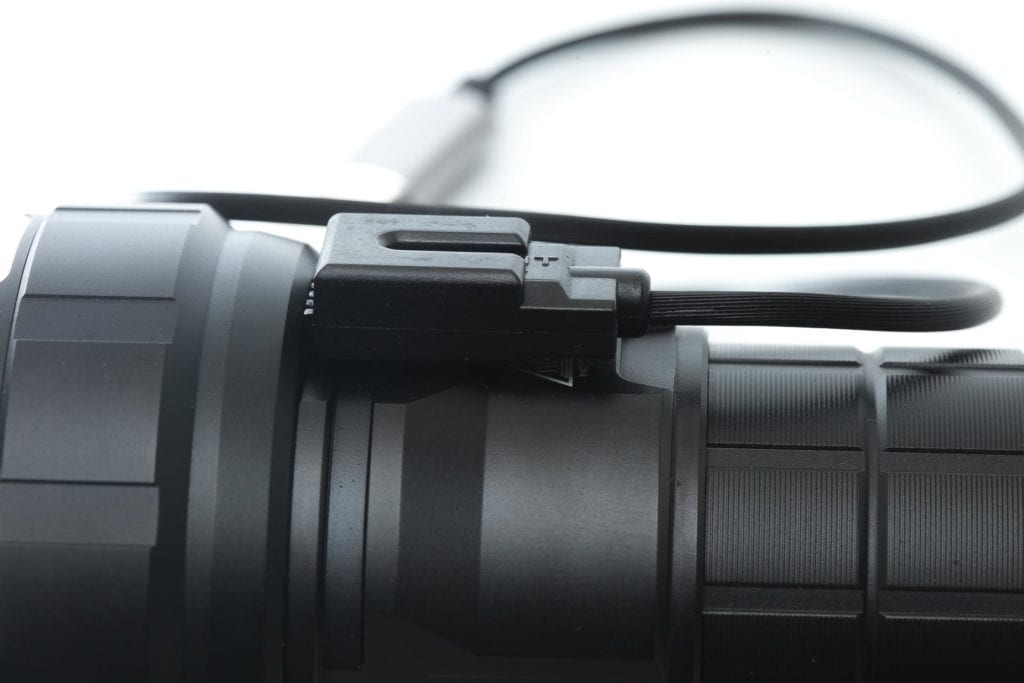
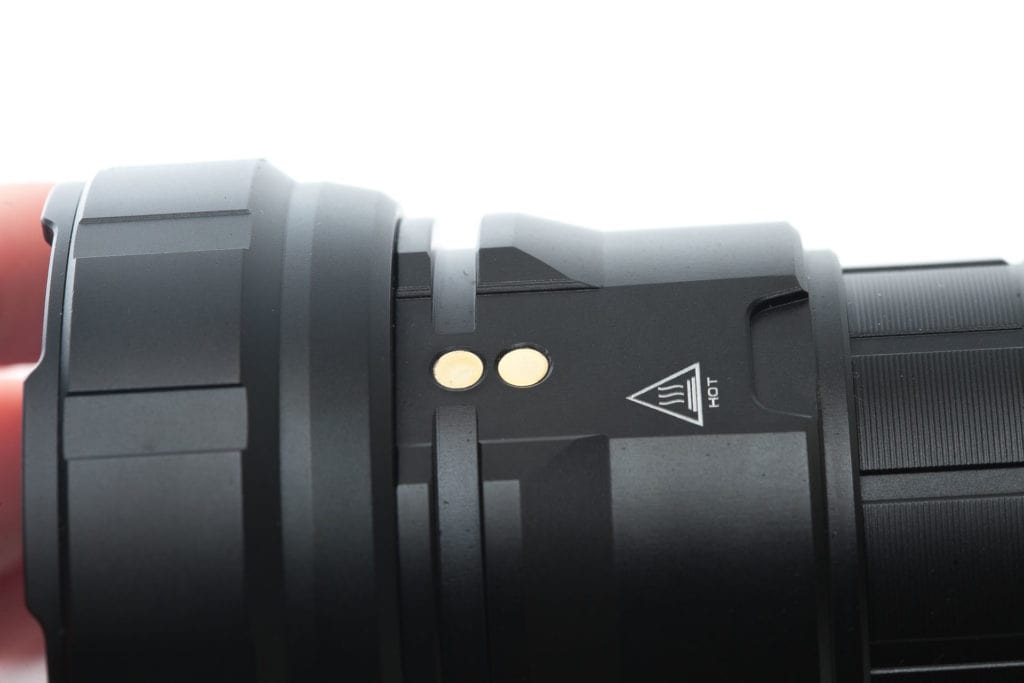
Performance
This is the gear I used for testing:
| Gear | Purpose | Link to buy |
|---|---|---|
| Hagner E4-X | Measuring beam intensity (throw) | Inquire at Hagner.se |
| Extech SDL400 | Lumens and logging runtimes | Amazon.com, Amazon.co.uk, |
| Leica Disto D2 | Distance for throw measurements | Amazon.com, Amazon.co.uk, |
| Uni-T UTi260B | Thermal camera | Amazon.com, |
Lumen measurements:
All output numbers are relative to my homemade Integrating Sphere. It is set up with an Extech SDL400 Lux Meter for measurements including a Kenko PRO1D ND-16 filter. The base measurement is done with a Convoy S2+ that has been tested at 255 lumens.
For Amp readings, I use a Fluke 77III DMM. For higher amps I now use a Fluke 325 True RMS clamp meter. For microamps, I use a cheap DMM with an easy-to-use micro amp setting.
All of my readings were taken from fully-charged Imalent MRB-217P40S batteries. The measurements for turn on, and 30 seconds were manually taken, and the 10 minutes measurements are taken from the runtime chart.
| Amp at start | Specs | start | 30 sec | 10 minutes |
|---|---|---|---|---|
| Low | 300 | 293 lm | 293 lm | 286 lm |
| Mid Low | 600 | 509 lm | 508 lm | 494 lm |
| Mid1 | 1,800 | 1,449 lm | 1,437 lm | 1,363 lm |
| Mid 2 | 3,500 | 3,333 lm | 3,290 lm | 3,077 lm |
| High | 6,500 | 6,855 lm | 6,665 lm | 3,592 lm |
| Turbo | 20,000 | 20,302 lm | 16,939 lm | 3,659 lm |
Runtime:
The runtime test was done with the 50cm integrating sphere, including the Kenko Pro1D ND-16 filter and Extech SDL400 data logging Lux Meter.
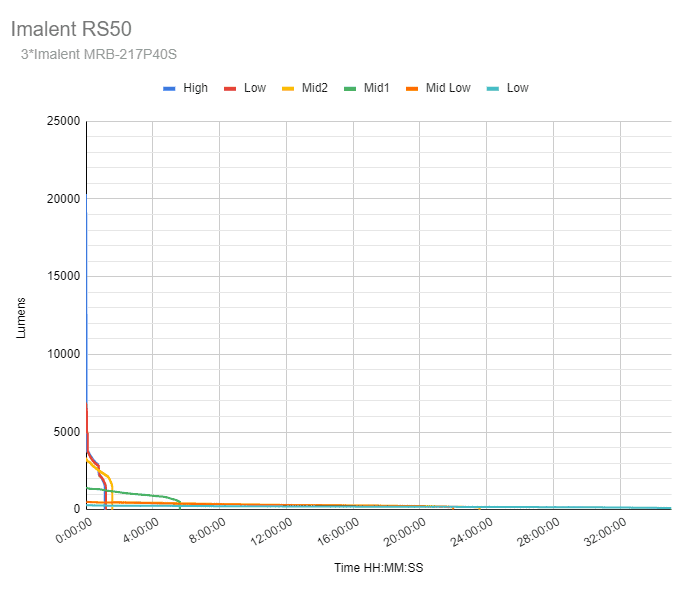

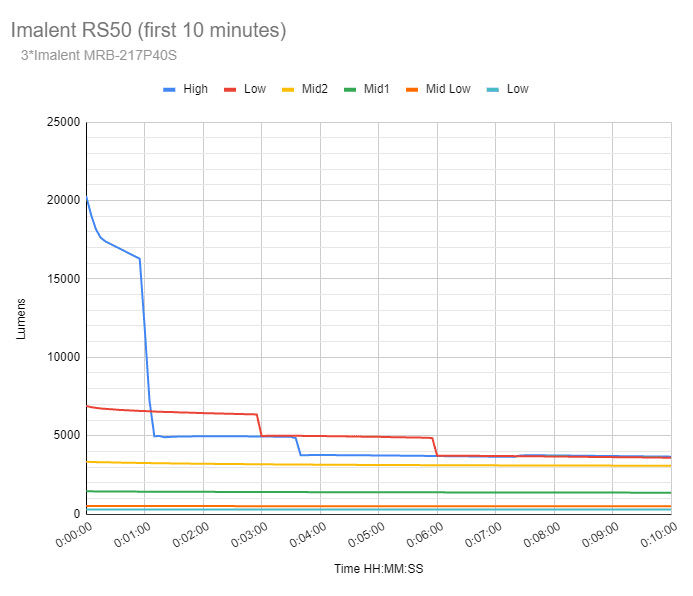
Turbo: starts just above 20,00 lumens and drops to 16300 lumens just before 1 minute when it plunges down to 4900 lumens. After 3.5 minutes it drops from 4900 lumens to 3750 lumens.
From that point onward it slowly decreases and at 1h07min it measures 1511 lumens before it turns off.
High starts at around 6850 lumens and slowly decreases. The first big drop happens at 3 minutes when it drops from 6350 lumens down to 4970 lumens. The next happens at the 6-minute mark from 4842 to 3700 lumens. It slowly decreases output till it reaches 1470 lumens after 1h11min when it suddenly turns off. (specs: 55min)
Mid2 starts at around 3340 lumens and slowly decreases. There are no hard step-downs, but the last measured output is at 1h33min: 1511 lumens, before it turned off. (specs: 1h25min)
Mid1 starts at around 1450 lumens and also has no hard step-downs. After 5h36min the output is down to 510 lumens before it shuts off. (Specs: 2h18min)
Mid low starts at just below 510 lumens, and slowly reduces output. At 21h59min the last measured output is 159 lumens before it shuts off. (specs: 7h30min)
Low starts at around 290 lumens and runs for 35h03min when it reaches 105 lumens before it turns off. (specs: 30hours)
The specs are relatively close for Turbo, High, and Mid2, but Mid1 and Mid-Low are off by a large factor.
Throw Measurement
Measurements were taken both indoors and outdoors with a professional Hagner E4-X Lux Meter. The numbers below are from the 5-meter measurement. The 20-meter measurement was slightly lower.
For the 5 meter measurement, I set my meter to *100, because the reading is much more stable. But in reality, that’s not the most precise measurement of course. My lux meter can also measure *0.1 to have laboratory-style measurements, but then everything should be perfect, and that’s not feasible.
| Specs | Candela measured | in Meters | in Yards | Miles |
|---|---|---|---|---|
| 336,800 cd | 150,000 cd | 775 m | 847 yd | 0.48 mi |
I don’t know how Imalent measured 336,800 cd, because mine didn’t come farther than 150 kcd. I also measured at 20 meters distance, and that measurement was even lower.
336,800 should be about 1200 meters, but mine didn’t go beyond 775 meters.
Imalent RS50 vs Manker MK38 vs Imalent MS08 vs Acebeam X80-GT2
High power flashlight comparison
Here is the list with most of the high-power flashlights we reviewed in this category (Category: high-power soupcan sized flashlights).
| Flashlight | Max. Output | after 30sec |
|---|---|---|
| Acebeam X50 | 35,507 | 30,383 |
| Acebeam X75 | 64,295 | 73,716 |
| Acebeam X80-GT2 | 31,890 | 27,143 |
| Astrolux EC06 | 18,111 | 8,352 |
| Fenix LR50R | 11,698 | 10,849 |
| Imalent MR90 | 52,326 | 32,128 |
| Imalent MS08 | 25,745 | 19,615 |
| Imalent MS12 Mini | 68,773 | 46,750 |
| Imalent MS12 Mini C | 71,967 | 55,873 |
| Imalent RS50 | 20,302 | 16,939 |
| Imalent SR16 | 53,657 | 43,115 |
| Lumintop GT3 | 16,267 | 15,168 |
| Manker MK38 (SFT) | 16,013 | 13,129 |
| Olight Marauder 2 | 14,251 | 13,964 |
| Thrunite TN50 | 18,200 | 17,360 |
(Interactive line graphs below)
Hover your mouse over the lines in the graph to see more details, or select a flashlight in the graph.
Using a mobile phone? Hold your phone horizontally!
Another comparison, focusing on the first 10 minutes after activation
And here’s another comparison, but zoomed in. The first 60 minutes after activation.
Beamshots
For the following beamshots I used a Canon EOS 5D Mk2 and a 50mm lens. manual settings: ISO1600, 1/4sec , F4, 5000K
The shed is about 65 meters / 71 yards away, while the reflective fence and trees are about 200 meters.




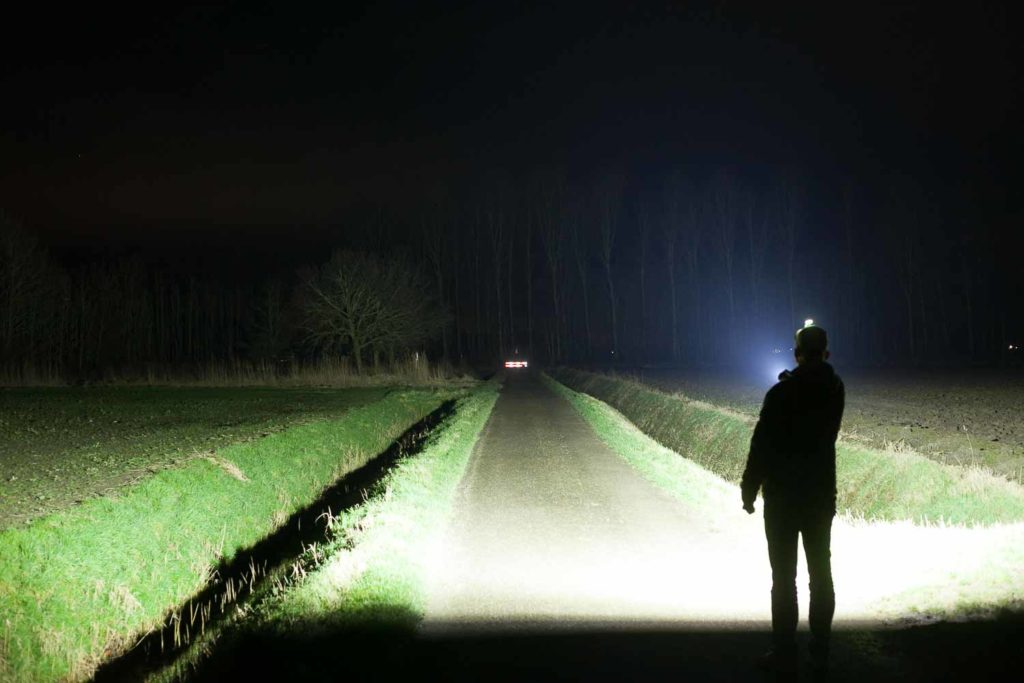
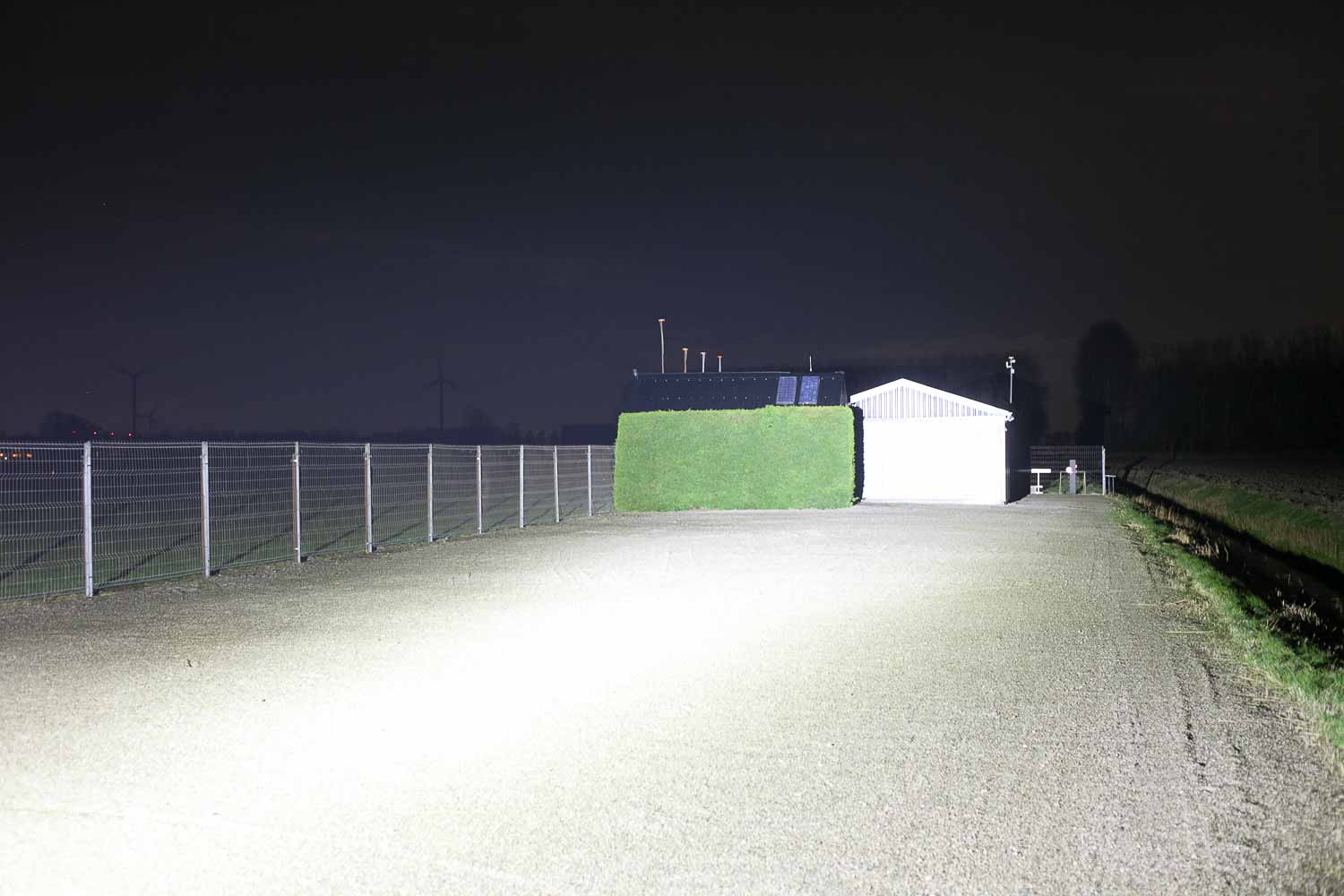
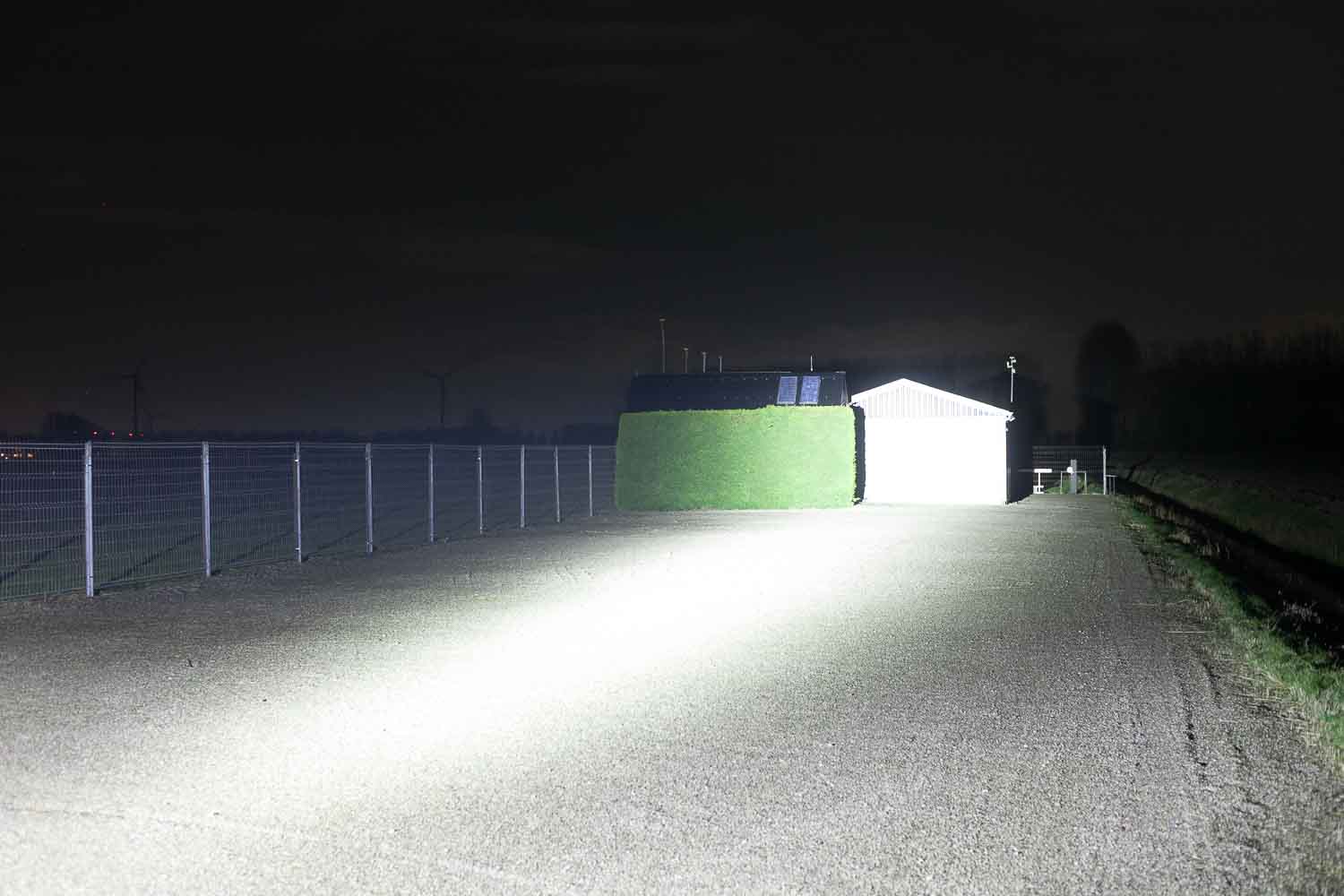
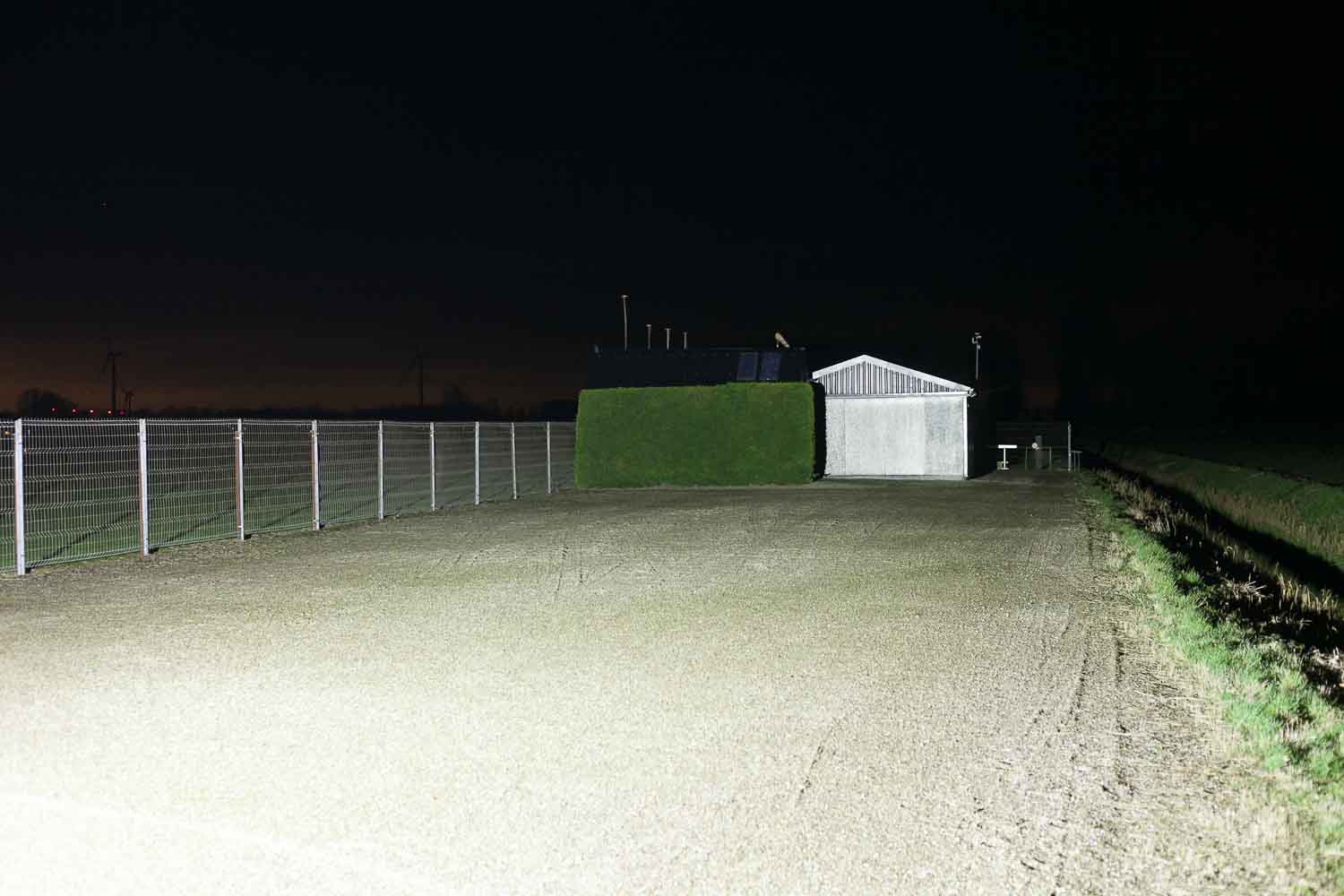
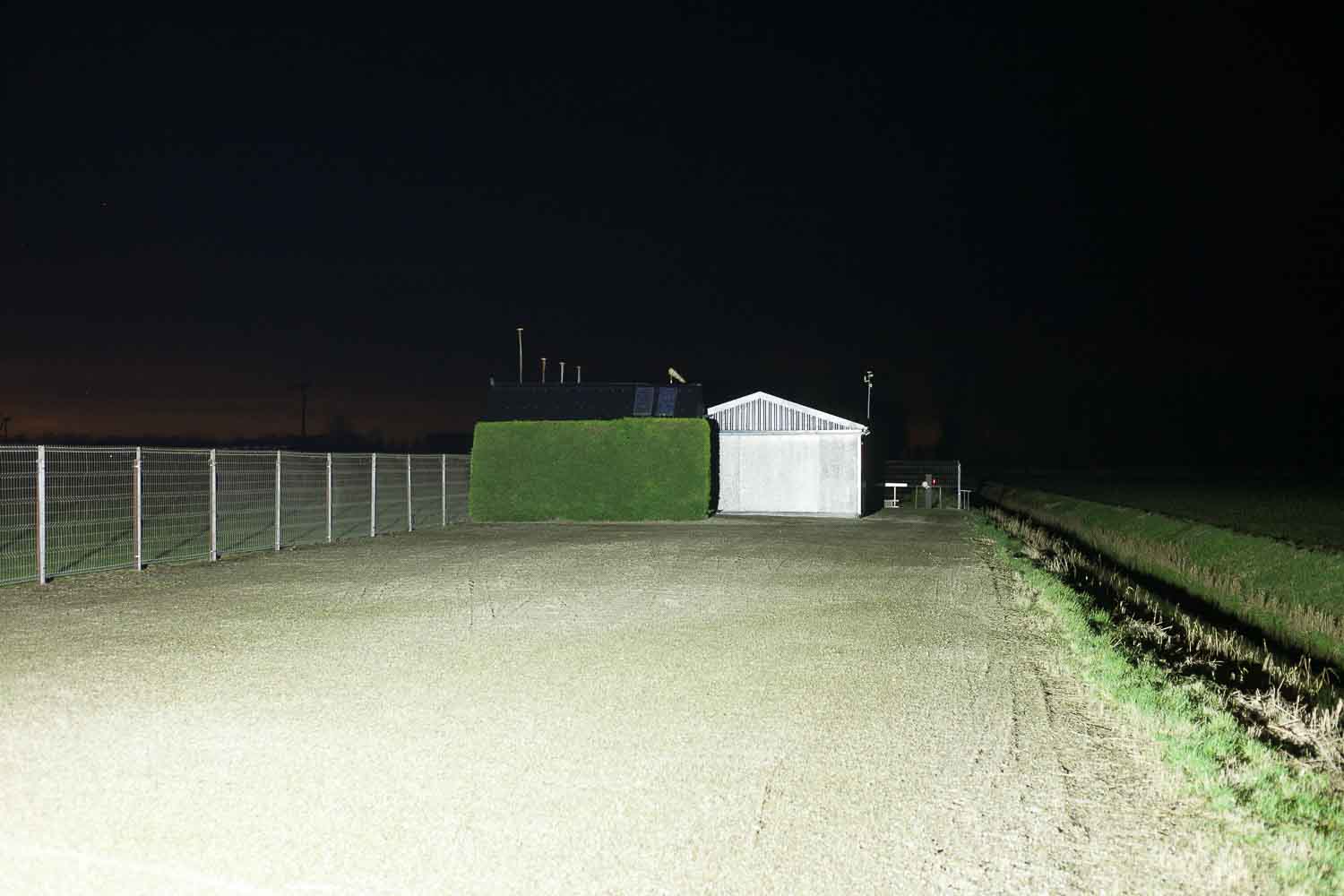
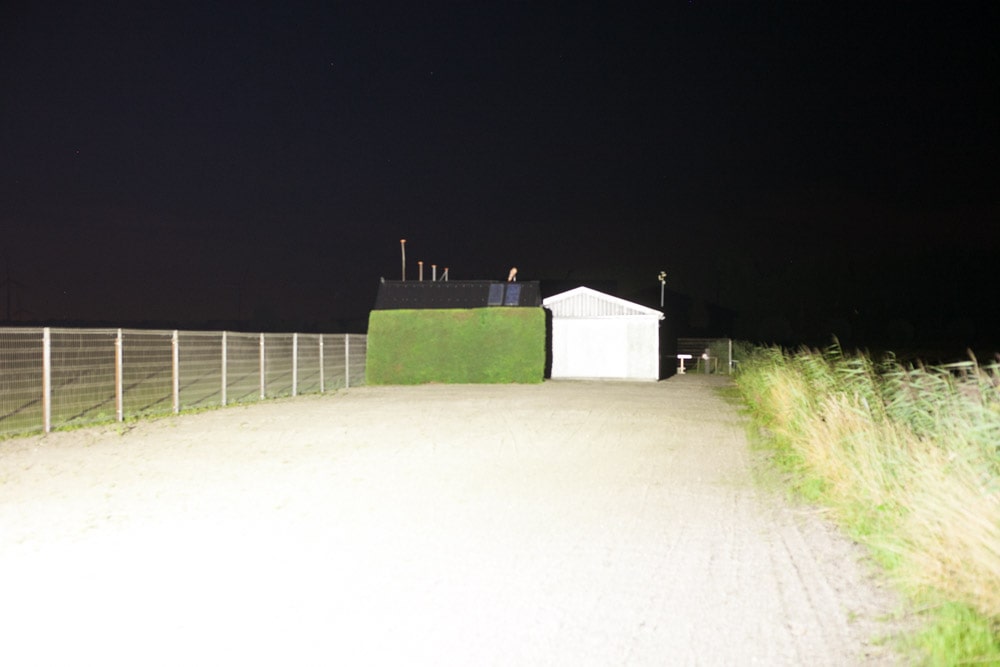
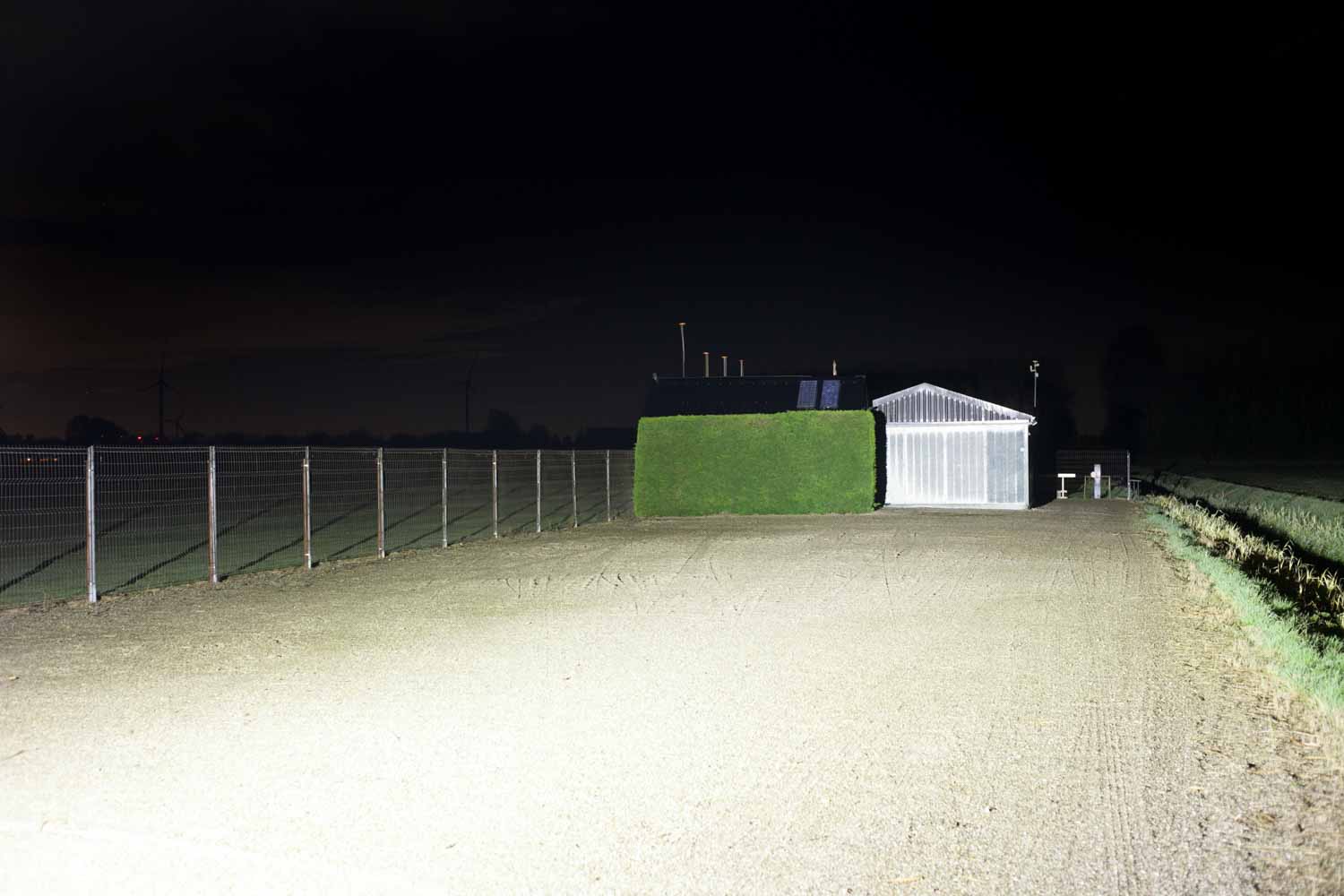
Disclaimer: This flashlight was sent to me for review at no cost by Imalent. I have not been paid to review, nor have I been holding back on problems or defects.
Final Verdict
Pros
- Looks identical to the Imalent MS08 with built in fans for cooling
- Very bright
- Runtimes are much longer than specs for Mid1 and Mid low
- Includes high quality batteries and holster
- Short cuts to Low and Turbo mode from on and off
Cons
- No tripod attachment
- Specs for throw are exaggerated
- No high sustained output
Explanation on star ratings:
1: Avoid: my phone flashlight would be a better choice – 2: Poor: significant defect or issues; almost unusable – 3: Average: some defects or issues; but still usable 4: Good: recommended (minor issues) – 5: Great: highly recommended

4.0 stars: ★★★★
The specs of the flashlight are not very accurate in terms of throw distance. I was barely able to get 50% of what was claimed. Not saying that the actual performance is poor, because 20,000 lumens at turn-on is bright like the sun.
The plastic shell with cooling fans really helps your hands from burning, because the flashlight gets really hot, pretty fast.
If you’re looking for a high-power flashlight that isn’t much bigger than a soda, also consider the RS50.
Imalent RS50 discount coupon
Get 10% off with our exclusive coupon code: 1Lumen
1lumen selects and reviews products personally. We may earn affiliate commissions through our links, which help support our testing.